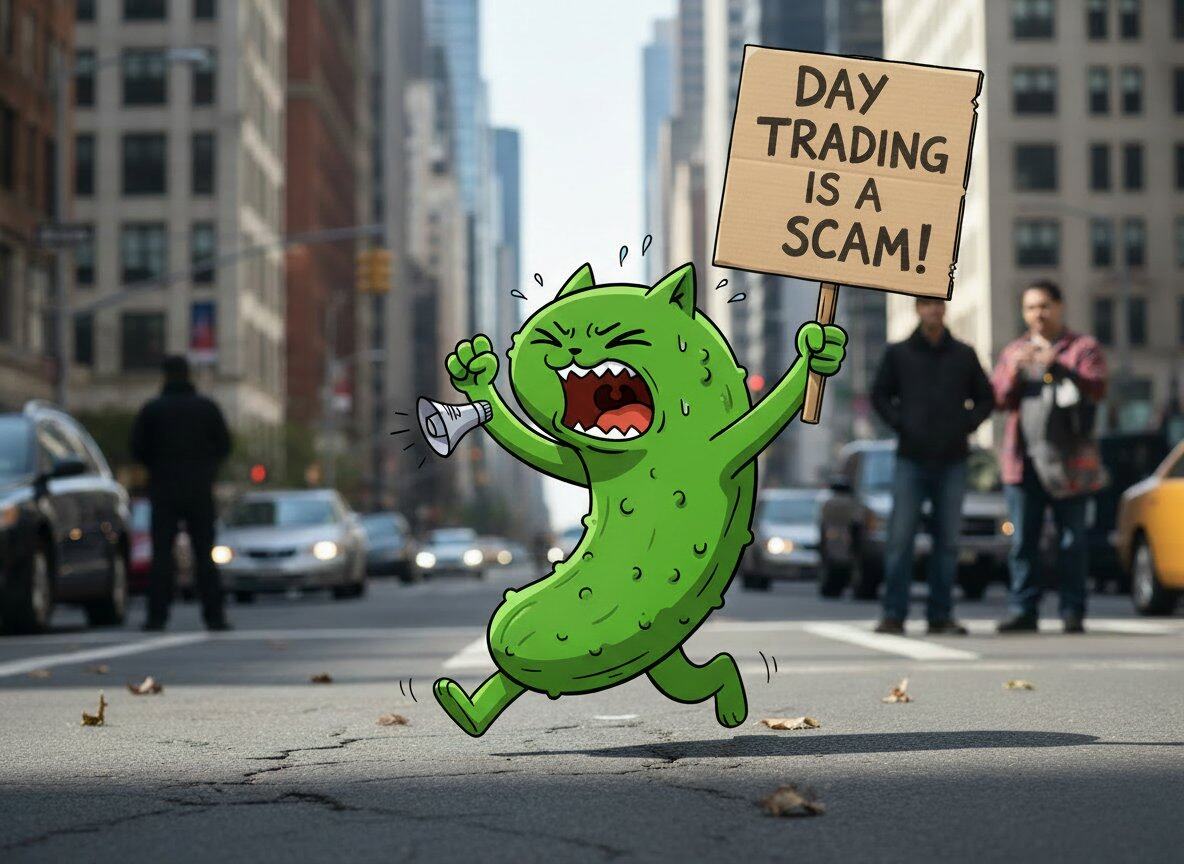a16z 2025 Crypto Industry Report: The Year of Mainstreaming
- 核心观点:加密货币行业已进入成熟发展阶段。
- 关键要素:
- 加密总市值突破4万亿美元。
- 稳定币年交易量达46万亿美元。
- 传统金融机构全面拥抱加密资产。
- 市场影响:推动全球金融体系数字化升级。
- 时效性标注:长期影响
This article comes from: a16z crypto
Compiled by Odaily Planet Daily ( @OdailyChina ); Translated by Azuma ( @azuma_eth )
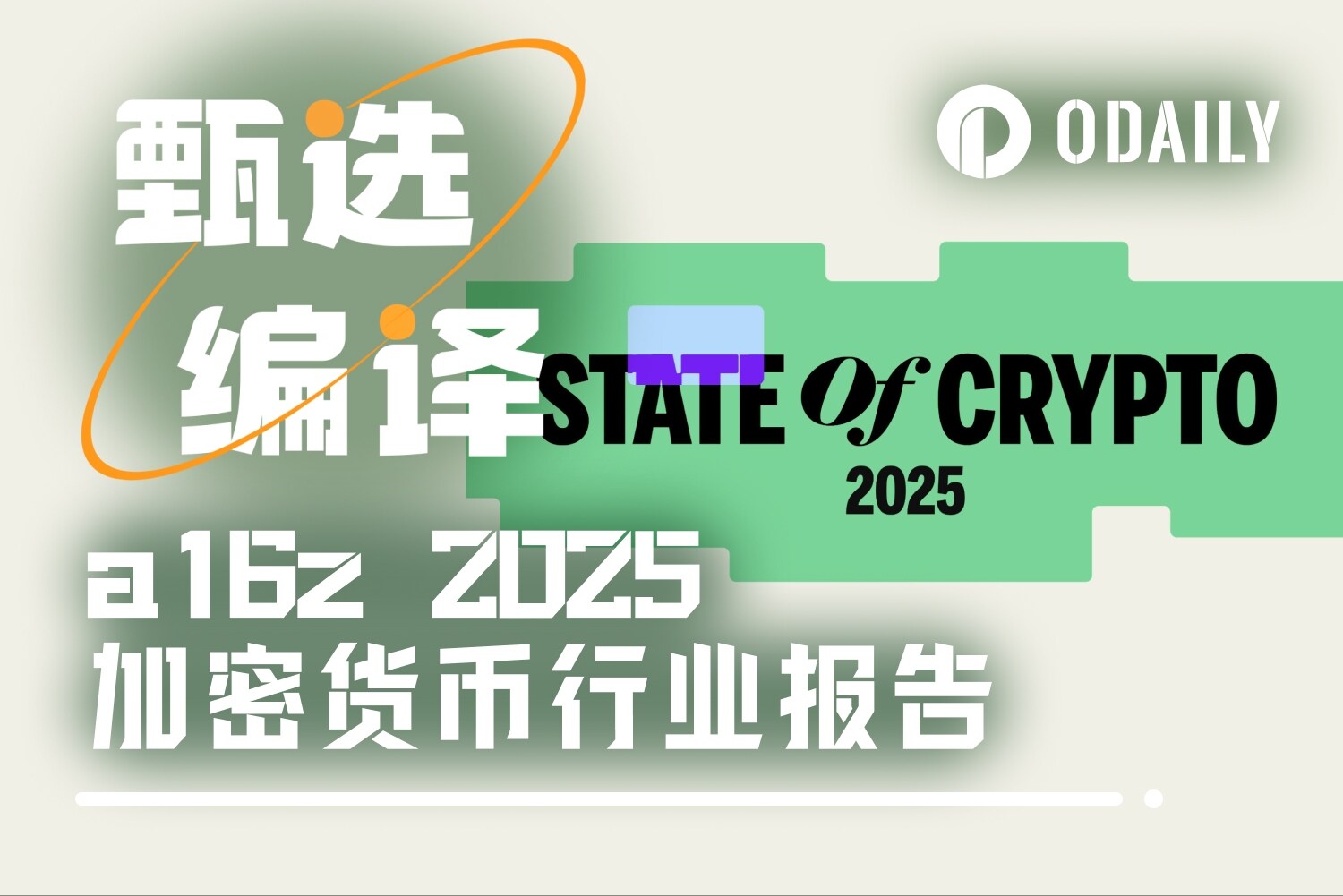
The Year of the World 's Blockchain
When we published our first " State of Crypto" report in 2022, the industry was still in its teens. The total value of the crypto market was less than half of what it is today. Blockchains were slower, more expensive, and less reliable.
Over the past three years, the builders of the cryptocurrency industry have weathered severe market corrections and political uncertainty, yet they have continued to improve infrastructure and advance technology. These efforts have brought us to where we are today—a moment when the cryptocurrency industry is becoming a vital part of the modern economy.
The crypto story of 2025 is one of industry maturity.
In short, cryptocurrencies have grown up:
- Traditional financial giants such as Visa, BlackRock, Fidelity, and JPMorgan Chase, as well as tech-native challengers PayPal, Stripe, and Robinhood, are all offering or launching cryptocurrency products.
- Blockchains can now process over 3,400 transactions per second (more than 100 times the rate of five years ago).
- Stablecoins support $46 trillion ($9 trillion adjusted) in annual transaction volume, comparable in size to Visa and PayPal.
- The total assets of Bitcoin and Ethereum ETF products have exceeded US$175 billion.
In our latest "State of Crypto" report, we delve into this industry transformation, from institutional adoption to the rise of stablecoins to the convergence of cryptocurrency and artificial intelligence. And this year, we debuted a new way to explore this data—the State of Crypto Dashboard—which allows readers to track the industry's evolution in real time using key metrics.
Here are our key findings.
Key Points
- A large, global market that continues to grow;
- Financial institutions fully embrace cryptocurrencies;
- Stablecoins are going mainstream;
- The influence of cryptocurrency in the United States has never been greater;
- The world is moving on-chain;
- Blockchain infrastructure is (almost) ready for prime time;
- Cryptocurrency and artificial intelligence are merging.
A large, global market that continues to grow
In 2025, the total crypto market capitalization exceeded $4 trillion for the first time, marking a significant milestone for the industry's overall development. Simultaneously, the number of mobile wallet users reached a record high, growing 20% year-over-year.
The shift from a once stringent regulatory environment to a more supportive policy climate today, coupled with the accelerated adoption of stablecoins, tokenization of traditional financial assets, and other emerging applications, will become the core driving forces of the next cycle.
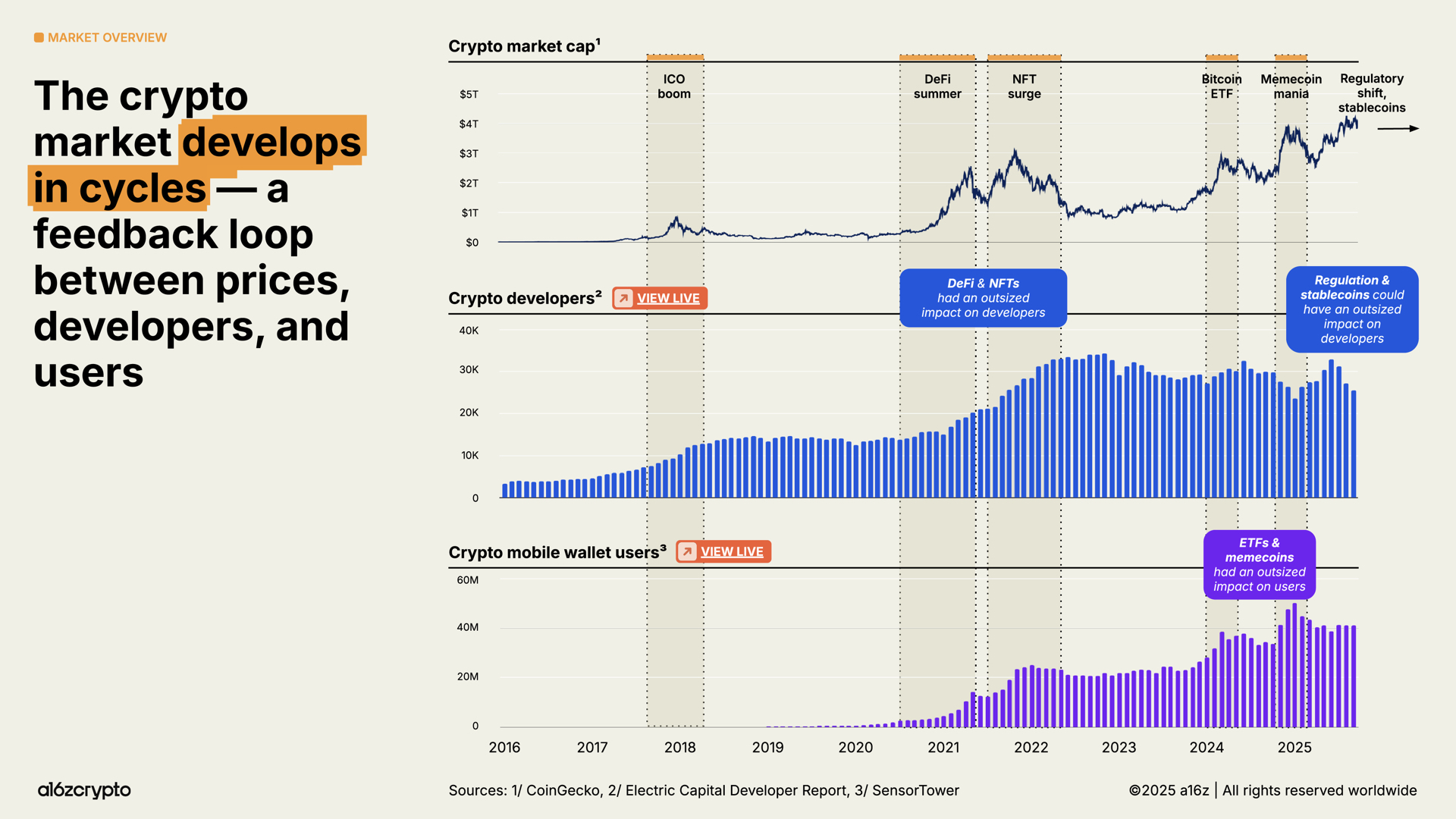
Our updated analysis, based on this methodology, estimates that there are currently approximately 40-70 million active cryptocurrency users, an increase of approximately 10 million since last year. This represents only a fraction of the estimated 716 million people who hold cryptocurrency, a 16% increase since last year, and a fraction of the estimated 181 million monthly active addresses on-chain, an 18% decrease since last year.
This gap indicates a significant potential gap between the "holding but inactive" demographic (those who own crypto assets but don't interact on-chain) and the "active on-chain users" (those who frequently transact on-chain). This means crypto builders have the opportunity to reach more potential users who already hold crypto but haven't yet deeply engaged in the on-chain economy.
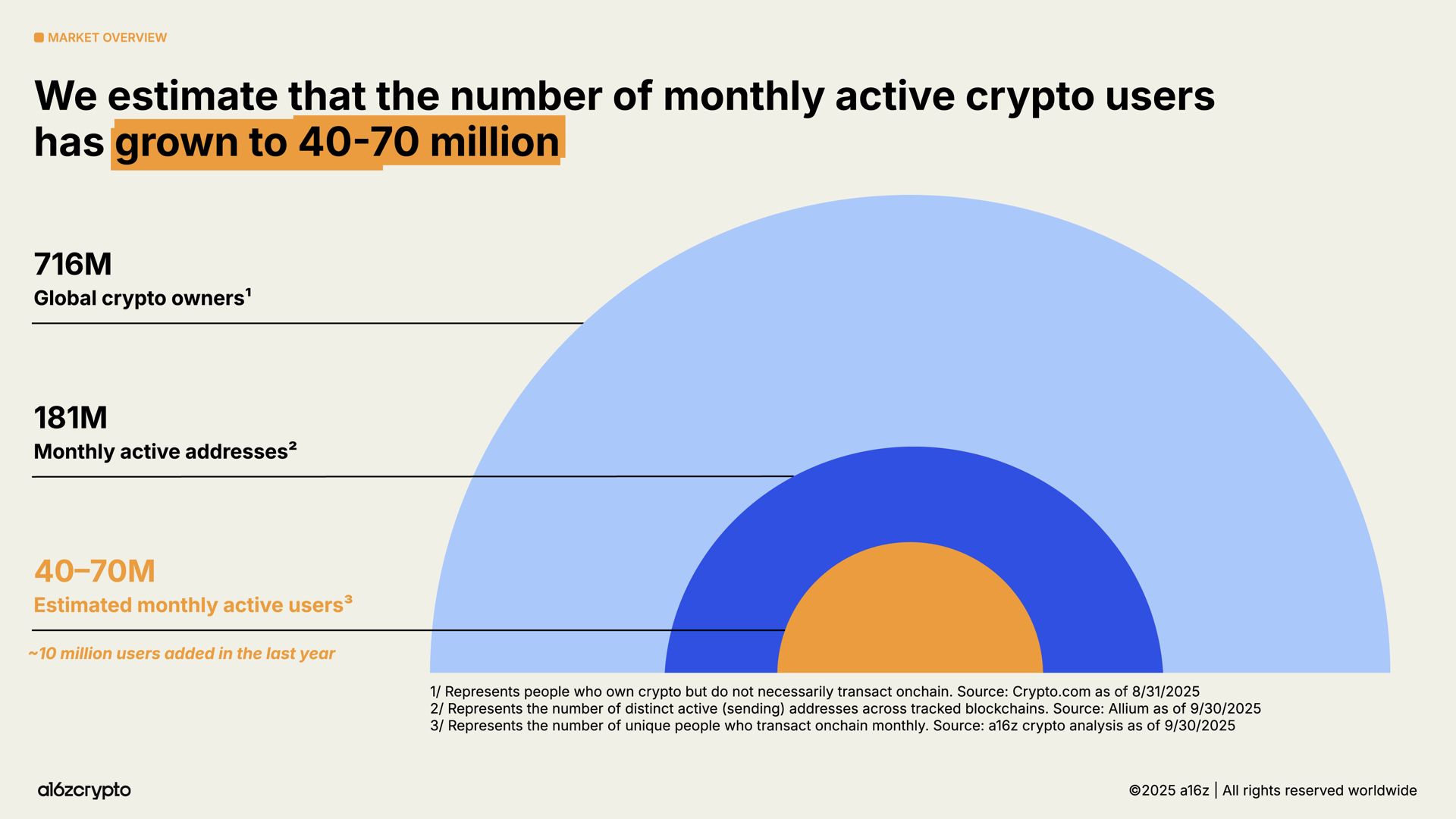
So where are all these cryptocurrency users, and what are they doing?
Cryptocurrency is global, but its adoption varies across regions. Mobile wallet usage (an indicator of on-chain activity) is growing fastest in emerging markets such as Argentina, Colombia, India, and Nigeria. In Argentina, in particular, cryptocurrency mobile wallet usage has increased 16-fold over the past three years, amid a deepening currency crisis.
Meanwhile, interest in content related to tokens is more concentrated in developed countries. Our geographic analysis of traffic sources for token-related webpages shows that activity in these countries (particularly Australia and South Korea) may be more focused on trading and speculation than user behavior in developing countries.
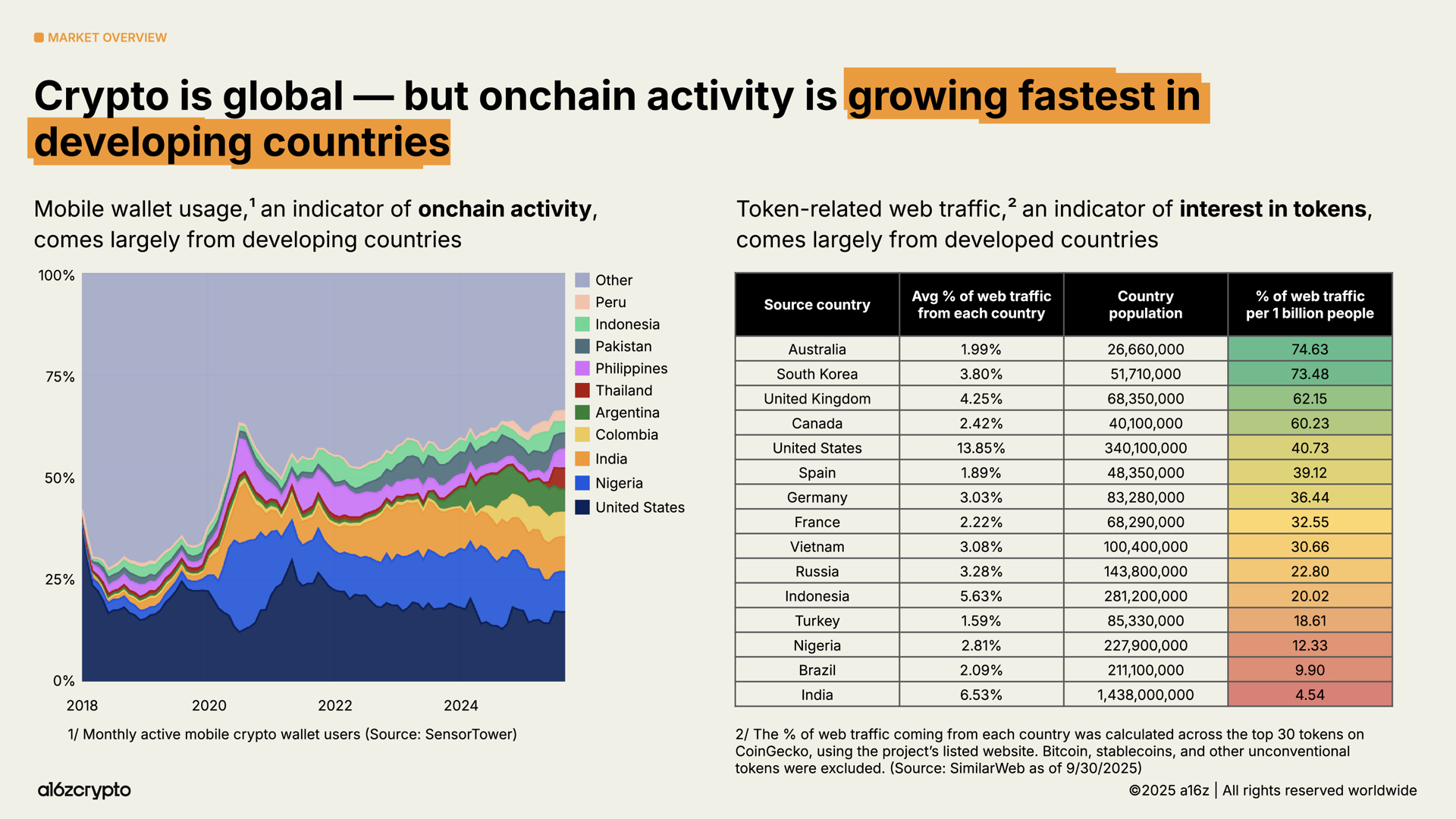
Bitcoin still accounts for more than half of the total cryptocurrency market capitalization, and its popularity as a store of value has reached a record high of over $126,000. Meanwhile, Ethereum and Solana have also recovered most of their losses since 2022.
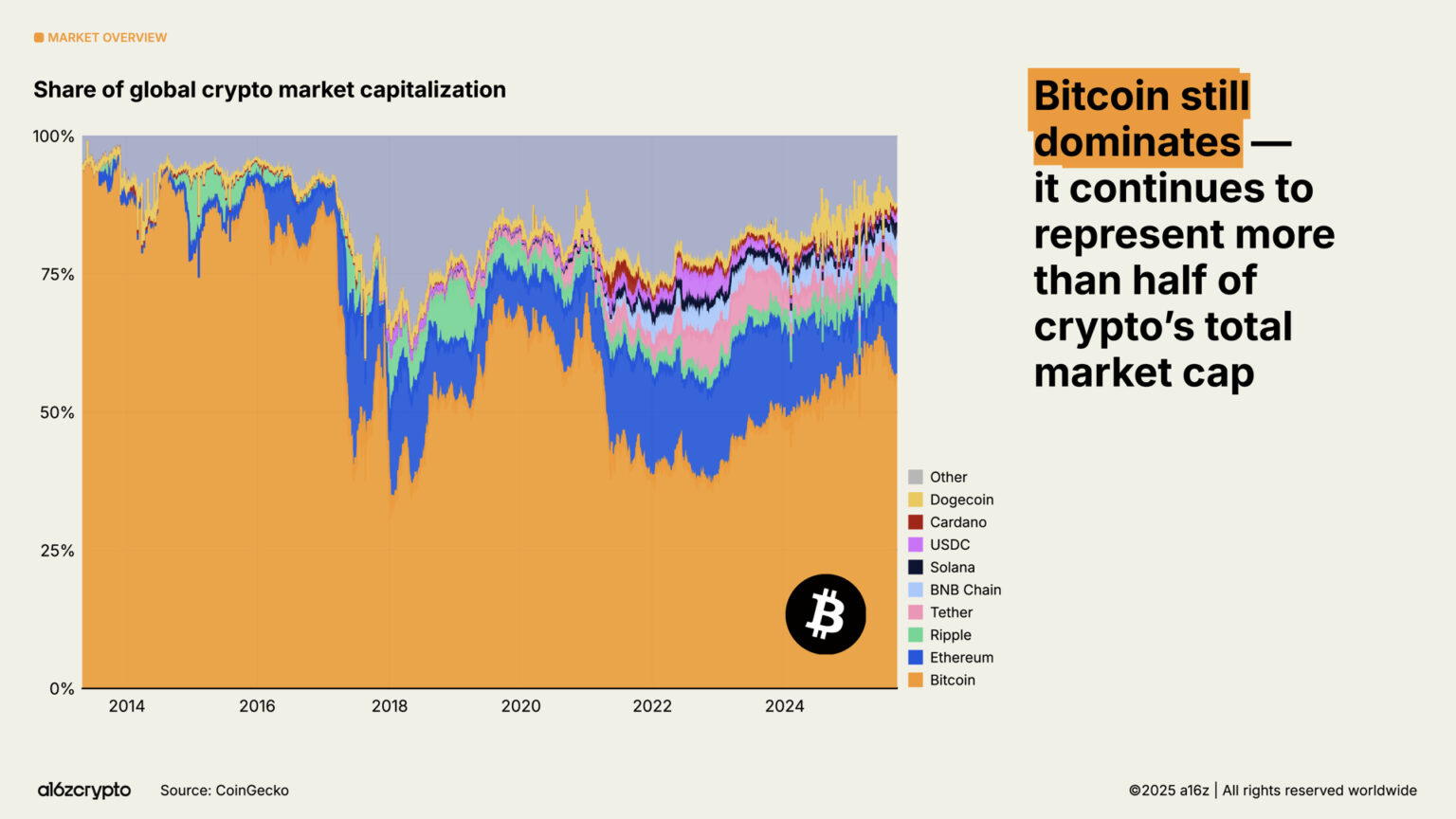
As blockchains continue to scale, fee markets mature, and new applications emerge, certain metrics are becoming increasingly important. One of these metrics is "real economic value"—a measure of how much people actually pay to use a blockchain. Currently, Hyperliquid and Solana account for 53% of revenue-generating economic activity, a significant shift from the dominance of Bitcoin and Ethereum in previous years.
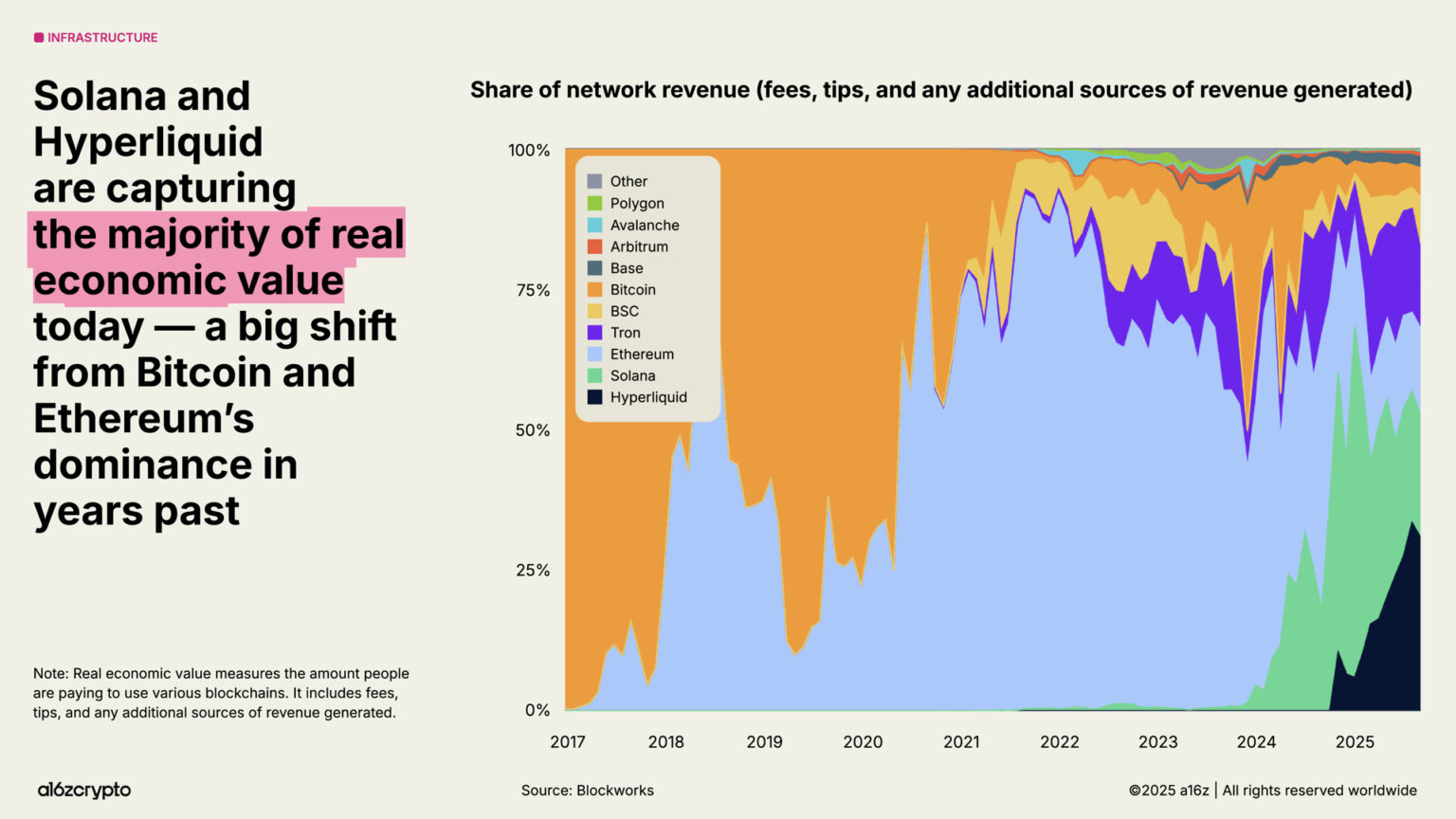
At the developer level, the crypto industry remains multi-chain. Bitcoin, Ethereum (and its Layer 2), and Solana are currently the most attractive ecosystems for developers. In 2025, Ethereum and its Layer 2 networks will be the top destinations for new developers. Meanwhile, Solana is one of the fastest-growing ecosystems, with developer interest increasing by 78% over the past two years.
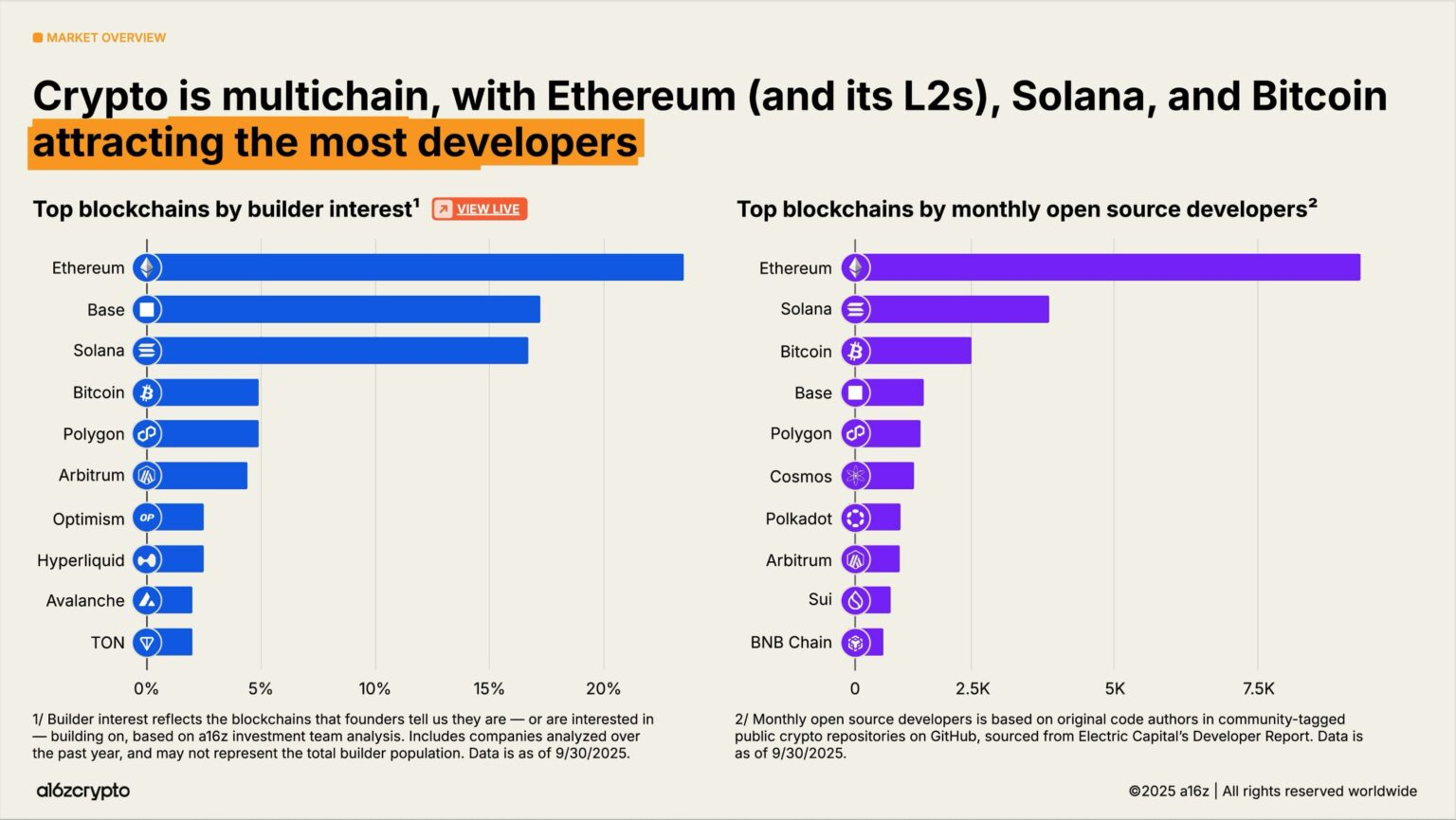
Financial institutions fully embrace cryptocurrencies
2025 is the year of institutional adoption. Just five days after the release of last year's "State of Crypto" report, in which we stated that "stablecoins have found product-market fit," Stripe announced plans to acquire the stablecoin infrastructure platform Bridge. With this, the race is officially on—traditional financial institutions are also preparing to openly enter the stablecoin space.
A few months later, Circle's multi-billion dollar IPO marked the official entry of stablecoin issuers into the ranks of mainstream financial institutions. And in July, the US Congress passed the bipartisan GENIUS bill, providing a clear legal framework and regulatory clarity for builders and institutions. In the months that followed, mentions of stablecoins in SEC filings increased by 64%, and related announcements from major financial institutions followed in rapid succession.
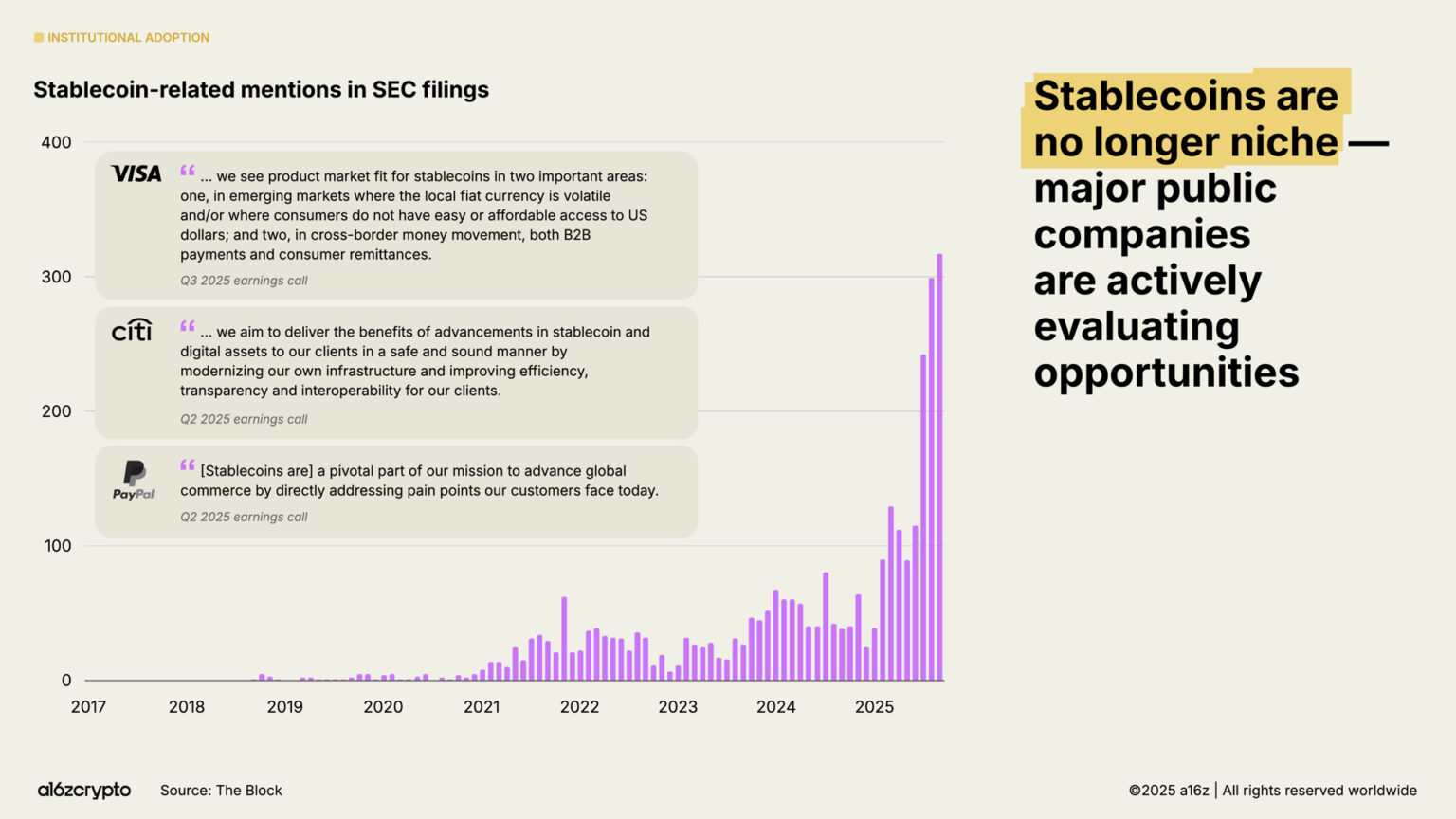
Institutional adoption is accelerating rapidly. Traditional financial giants—including Citigroup, Fidelity, JPMorgan Chase, Mastercard, Morgan Stanley, and Visa—have now begun (or plan to) offer crypto products directly to consumers, allowing users to buy, sell, and hold digital assets on the same platform as they trade stocks, ETFs, or other traditional financial products. Simultaneously, platforms like PayPal and Shopify are doubling down on their investments in the payments sector, building the infrastructure for everyday crypto transactions between merchants and consumers.
In addition to directly offering crypto products, major fintech companies—such as Circle, Robinhood, and Stripe—are actively developing or have announced plans to develop new blockchain networks, focusing on payments, real-world assets (RWAs), and stablecoins. These initiatives will drive more payment traffic onto blockchains, encourage enterprise adoption, and ultimately lead to a larger, faster, and more global financial system.
The biggest advantage these companies have is their ability to distribute it. If these developments continue, cryptocurrencies will become deeply integrated into the financial services we use every day.
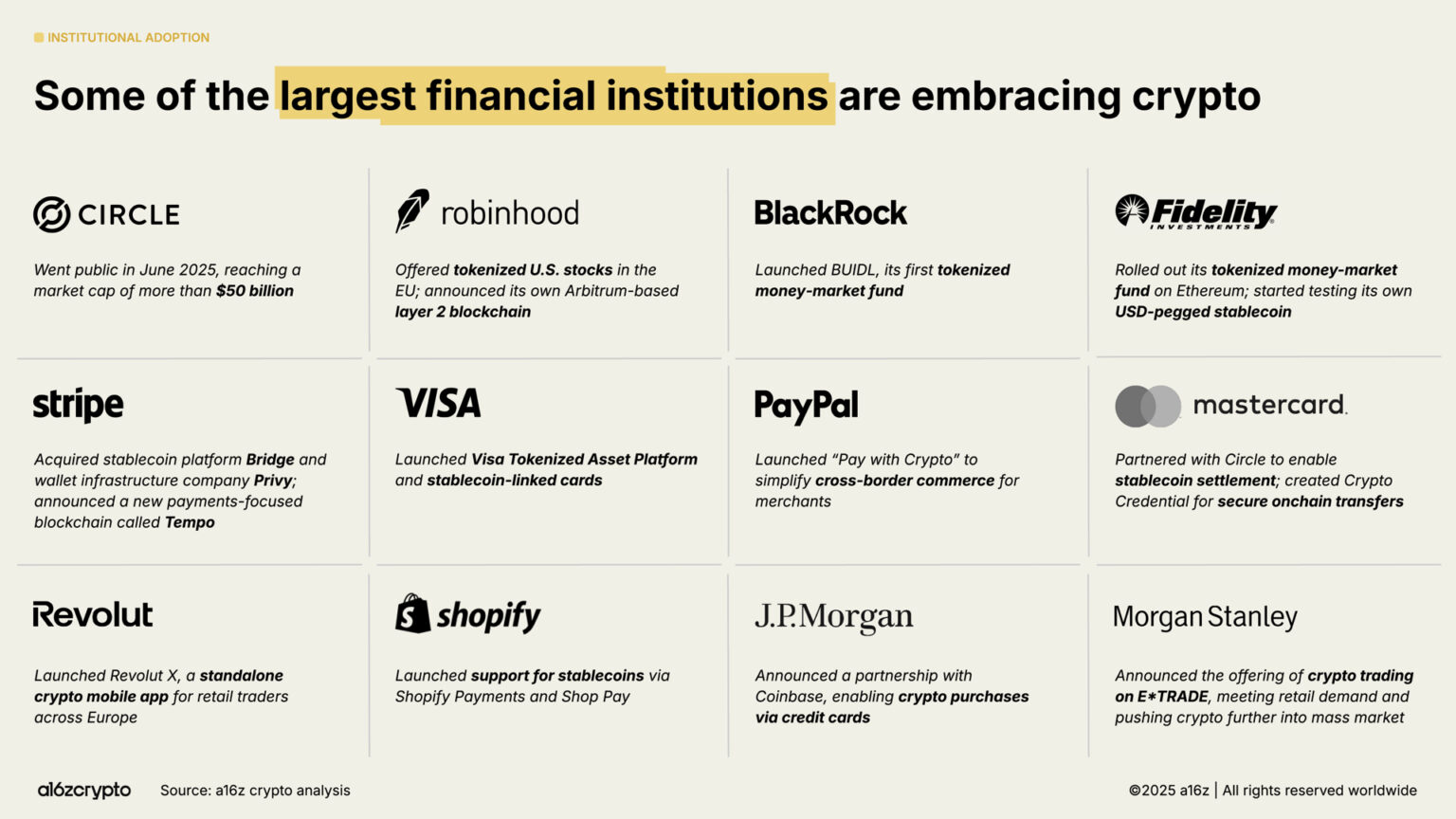
Exchange-traded products (ETPs) are another major driver of institutional investment, with on-chain crypto holdings now exceeding $175 billion, a 169% increase from $65 billion a year ago.
BlackRock's iShares Bitcoin Trust (IBIT) has become the most traded ETP in history; the subsequent Ethereum ETP has also attracted significant inflows in recent months. Although these products are often referred to as ETFs (Exchange Traded Funds), they are actually registered with the SEC as ETPs (Exchange Traded Products), using Form S-1, indicating that their underlying portfolios are not comprised of securities.
These products have greatly lowered the threshold for institutions to enter the crypto field, releasing a large amount of institutional capital that had previously been on the sidelines for a long time.
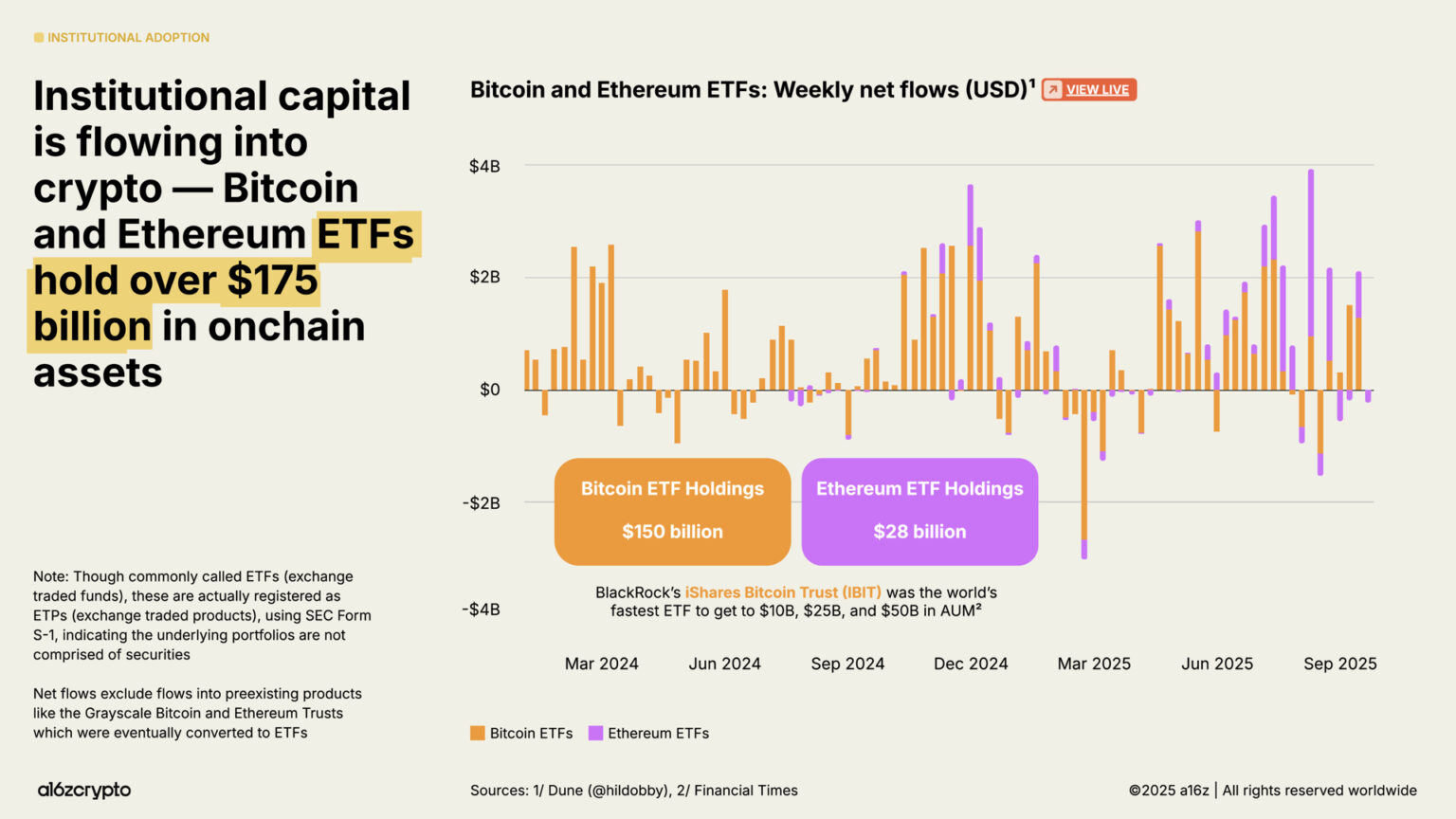
Publicly listed “Digital Asset Treasury” (DAT) companies—those that hold crypto assets on their balance sheets like traditional businesses hold cash—now collectively hold approximately 4% of all circulating Bitcoin and Ethereum. Combining these DATs with exchange-traded products, they now hold approximately 10% of the total Bitcoin and Ethereum token supply.
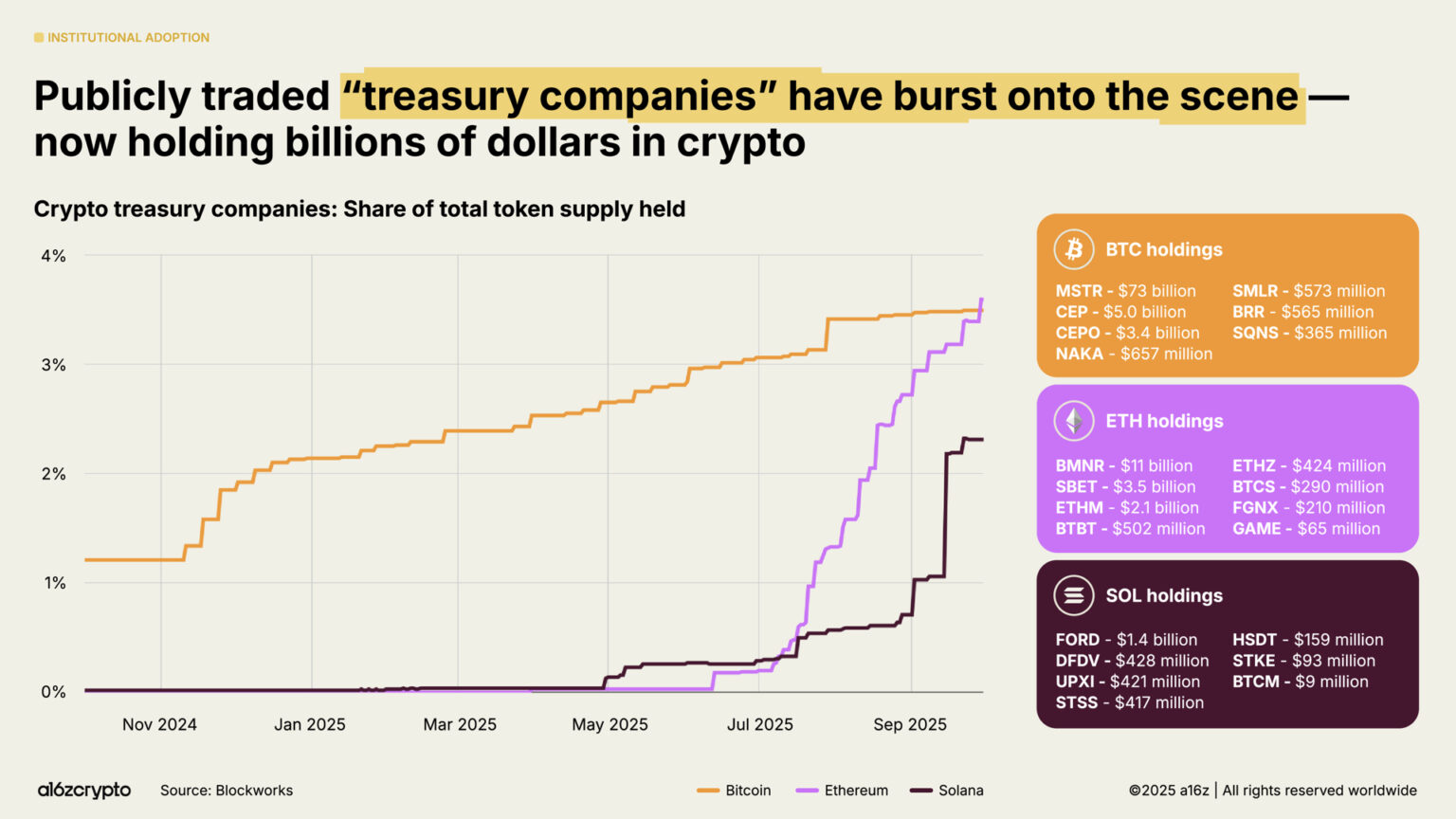
Stablecoins go mainstream
Nothing better exemplifies the maturity of cryptocurrency in 2025 than the rise of stablecoins. For the past few years, stablecoins were primarily used to settle speculative crypto trades; in recent years, they have become the fastest, cheapest, and most global way to transfer U.S. dollars—in less than a second, for less than a penny, to nearly anywhere in the world.
This year, they have become the backbone of the on-chain economy.
Over the past year, total stablecoin transaction volume reached $46 trillion, a 106% increase from the previous year. While this isn’t a completely apples-to-apples comparison (as the figure primarily represents money flows, while card networks focus on retail payments), it’s nearly three times Visa’s transaction volume and is on track to rival the size of ACH, the clearing network at the heart of the entire US banking system.
On an adjusted basis (a better measure of organic activity that filters out bots and other artificially inflated activity), stablecoins handled $9 trillion in trading volume over the past 12 months, up 87% from a year ago. That’s more than five times the volume processed by PayPal and more than half that of Visa.
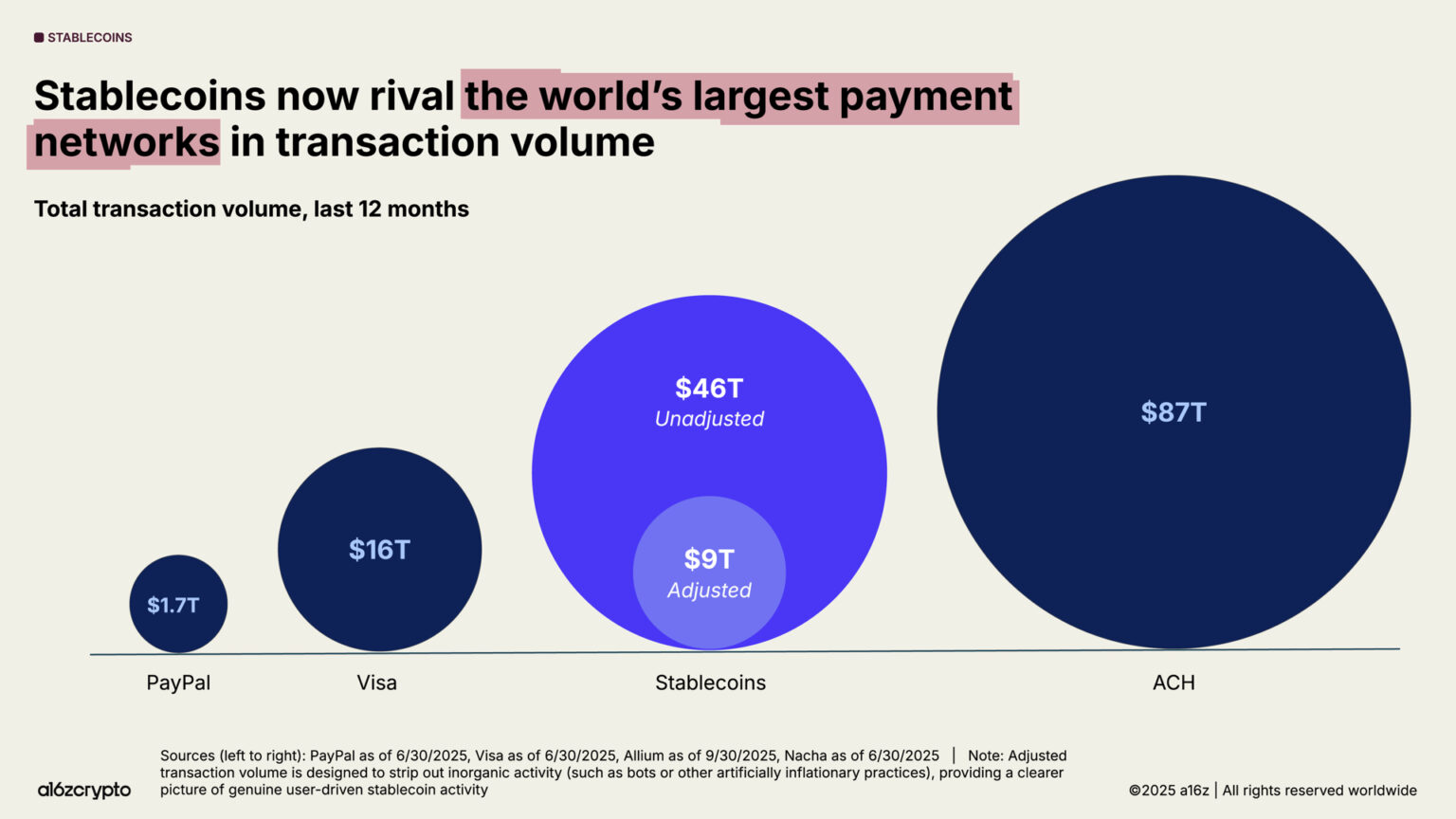
Stablecoin adoption is accelerating. In September 2025, adjusted monthly stablecoin trading volume reached $1.25 trillion, a record high. Notably, this growth showed little correlation with broader cryptocurrency trading volume, demonstrating that stablecoin usage is not driven by speculation but, more importantly, that they have achieved product-market fit.
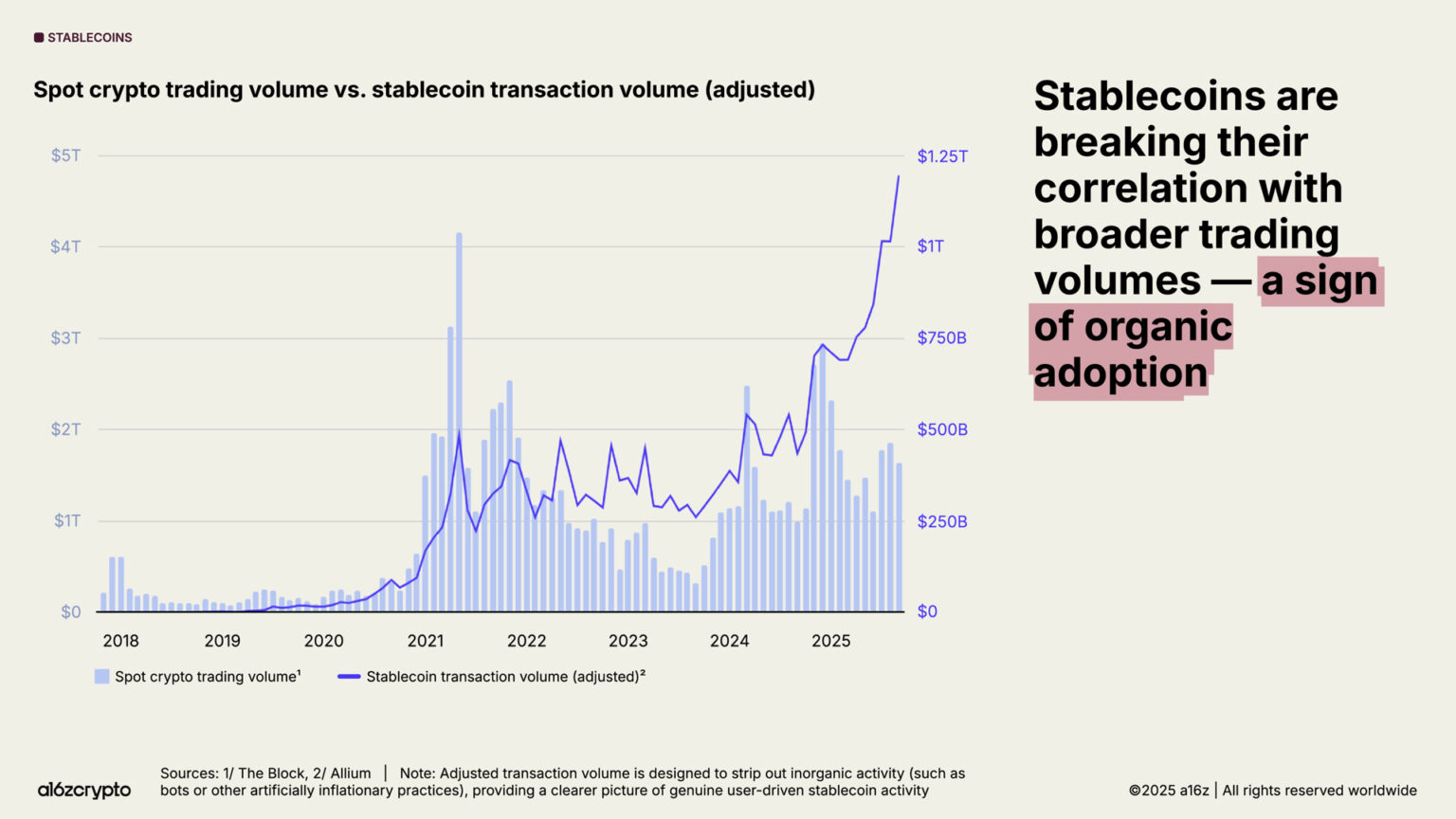
The total supply of stablecoins is also at an all-time high, currently exceeding $300 billion. USDT and USDC, the two largest stablecoins, account for 87% of the total supply. In September 2025, $772 billion in stablecoin trading volume (adjusted) was settled on Ethereum and Tron alone, representing 64% of all trading volume. While these two major issuers and public chains still dominate stablecoin activity, emerging public chains and new issuers are rapidly gaining momentum.
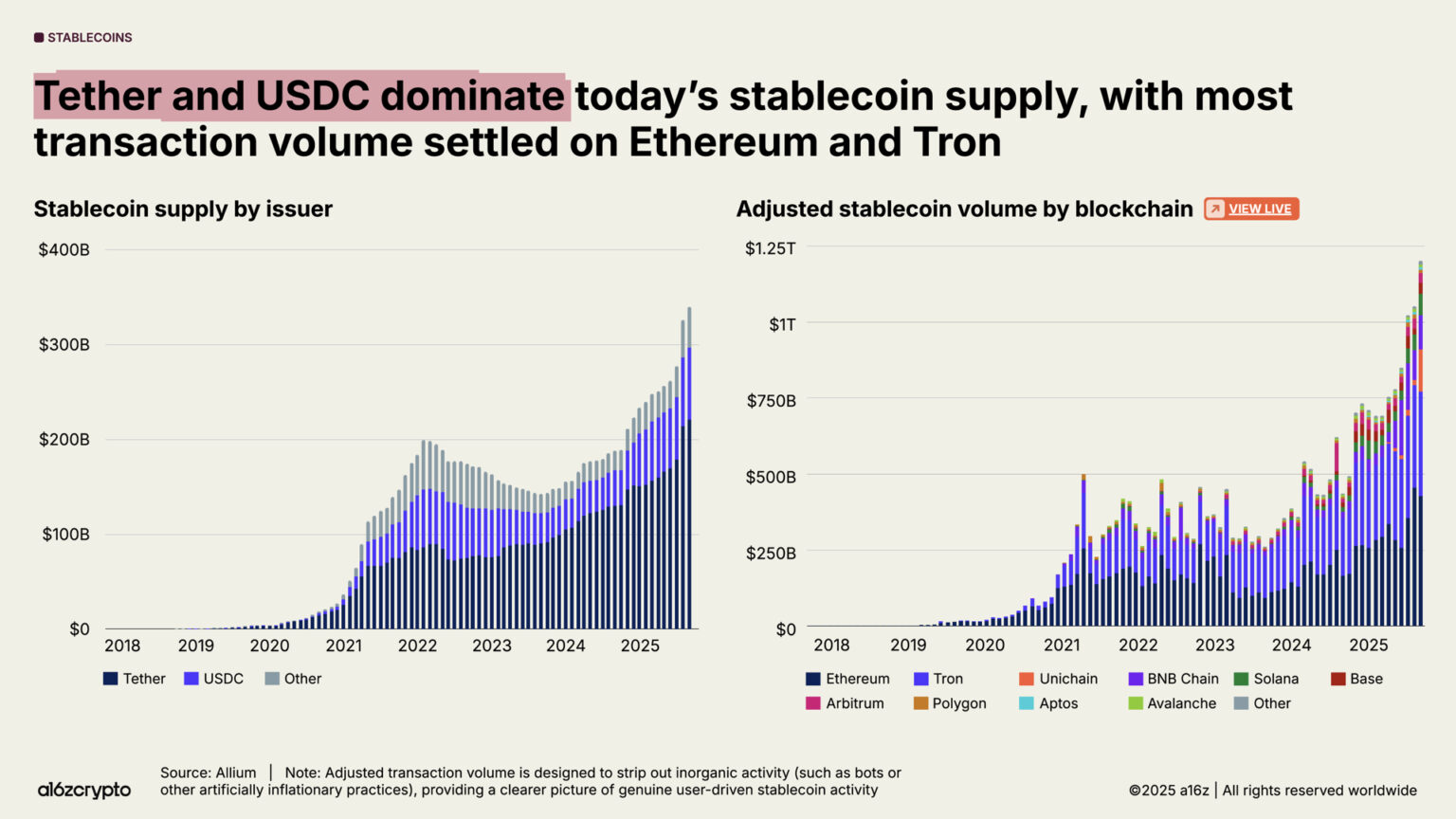
Stablecoins have become a global macroeconomic force—over 1% of the world's circulating U.S. dollar is now held in tokenized stablecoins on public blockchains. Furthermore, stablecoins have become the 17th largest holder of U.S. Treasury bonds, up three spots from 20th last year. Overall, stablecoins now hold over $150 billion in U.S. Treasury securities—a figure that exceeds the combined reserves of many sovereign nations.
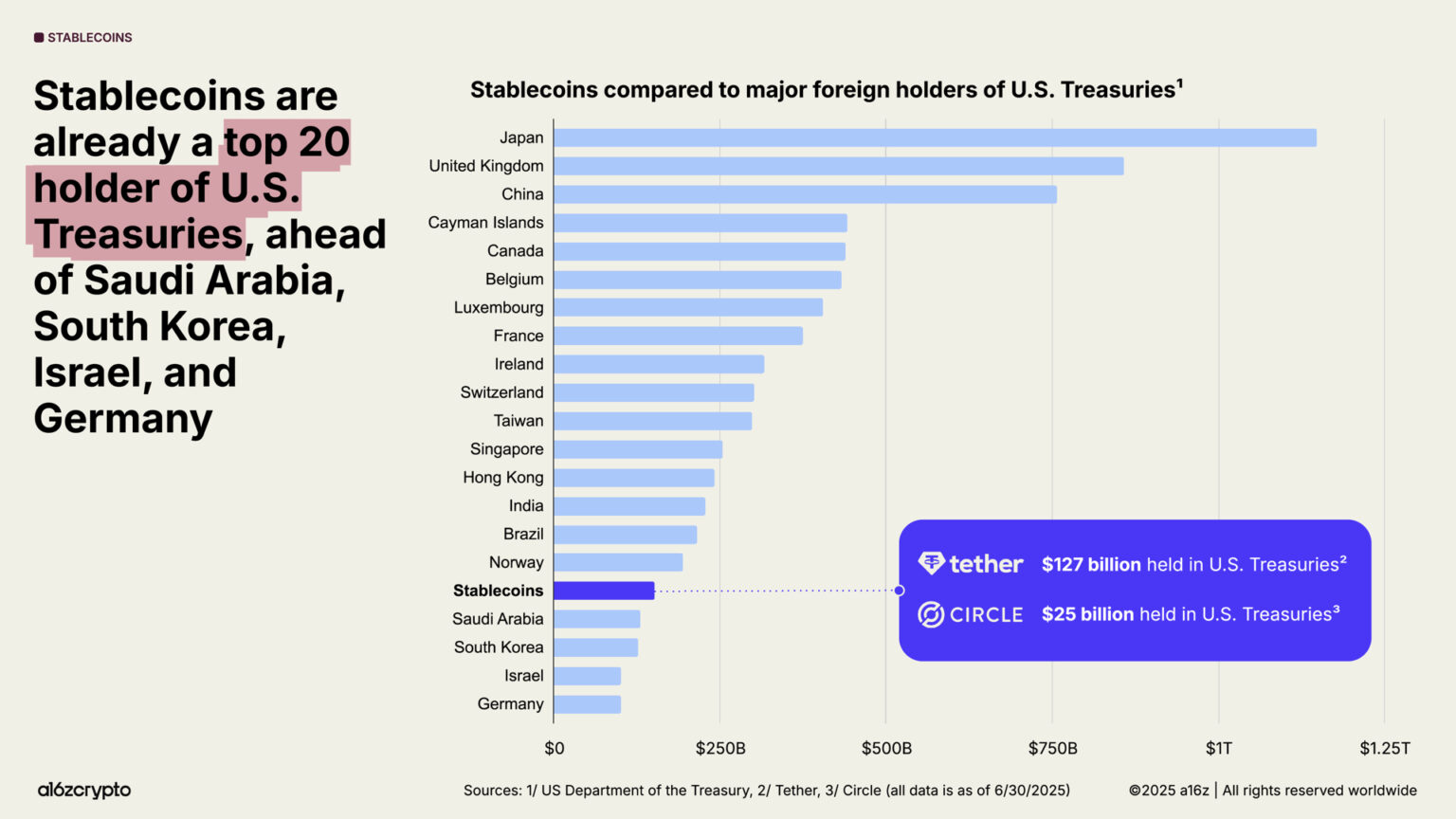
Meanwhile, the U.S. national debt continues to soar while global demand for that debt declines. For the first time in three decades, central banks now hold more gold in their foreign exchange reserves than U.S. Treasuries.
However, stablecoins are bucking this trend. Currently, over 99% of stablecoins are denominated in US dollars, and their total size is expected to grow more than tenfold by 2030, exceeding $3 trillion.
This means that stablecoins could become a strong and sustainable source of demand for U.S. debt in the coming years, reinforcing the dollar’s global dominance even as foreign central banks continue to reduce their holdings of U.S. debt.
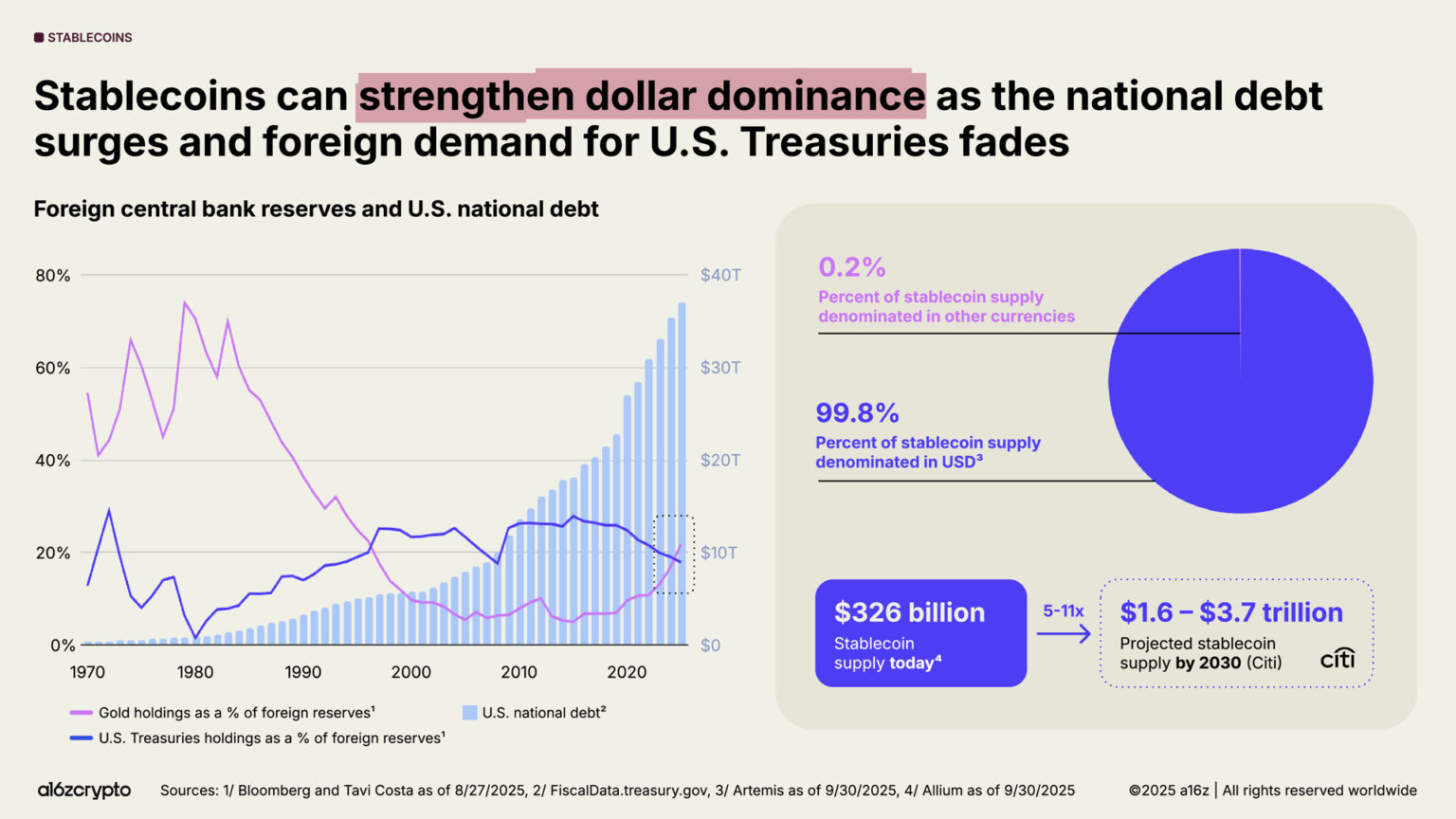
Cryptocurrency's influence in the United States is growing faster than ever
The United States has reversed its previous opposition to cryptocurrencies and rebuilt the confidence of builders.
The passage of the GENIUS Act this year and the House of Representatives' approval of the CLARITY Act mark a rare consensus between the two parties in the United States - the crypto industry will not only exist for a long time, but is also experiencing prosperity in the United States.
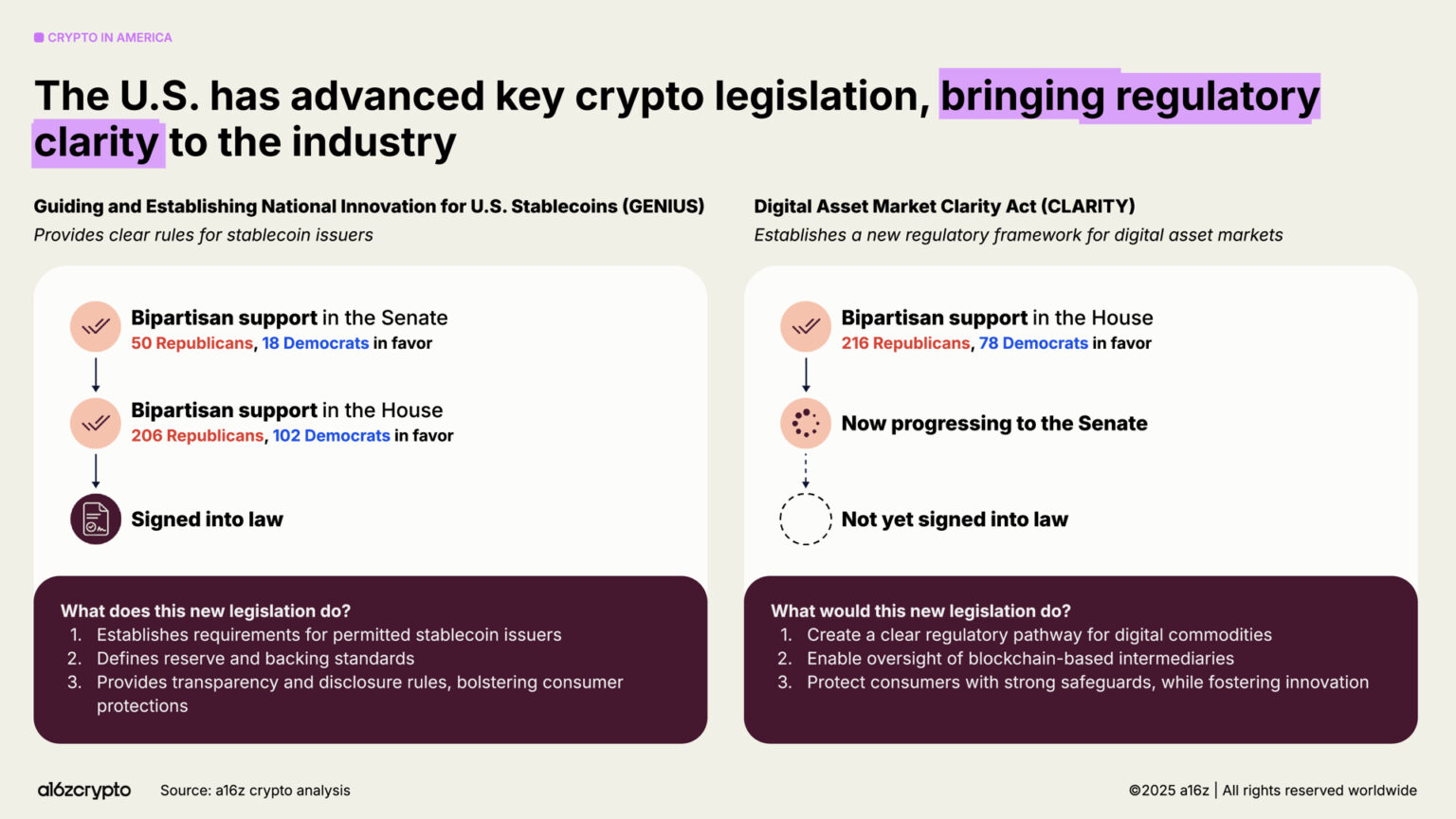
Together, these bills establish a framework for stablecoin regulation, market structure, and digital asset oversight, striking a balance between innovation and investor protection. Meanwhile, this shift was further reinforced by Executive Order 14178, which rescinded previous anti-crypto policy directives and established an interagency Digital Assets Task Force to modernize federal digital asset policy.
Today, the regulatory landscape is paving the way for builders to truly unlock the potential of tokens as a new digital primitive—much as websites once did for the previous generation of the internet. As regulatory frameworks become clearer, more and more network tokens will be able to close their economic loops, generating revenue from network activity and returning it to token holders. This will foster a new, self-propelled internet economic engine that is not only more sustainable but also allows more users to truly share in the economic benefits of the entire system.
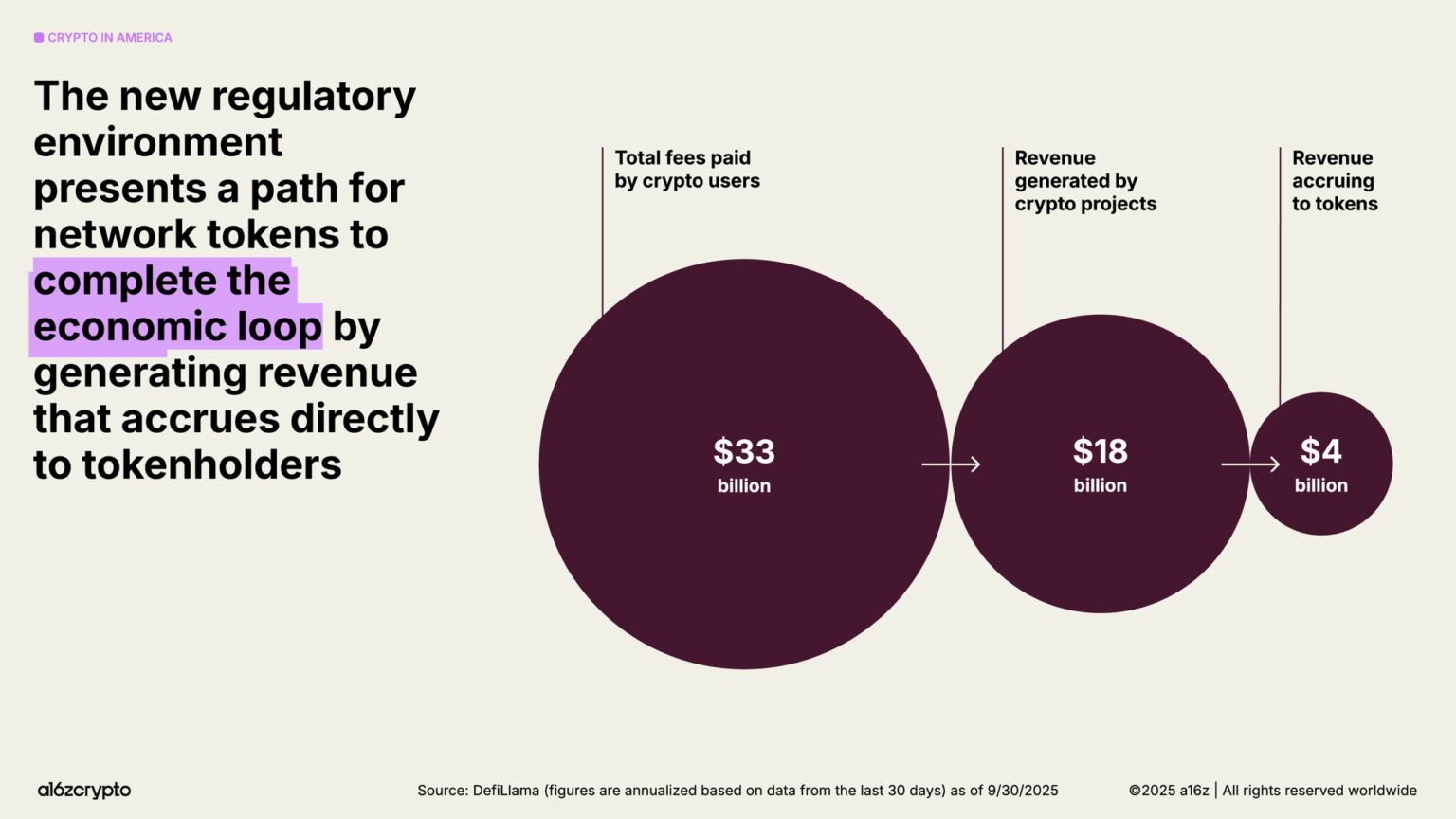
The world is moving on-chain
The on-chain economy—once a niche testing ground for early adopters—has evolved into a massive market across multiple industries, with tens of millions of active participants each month. Nearly one-fifth of all spot trading volume now occurs on decentralized exchanges (DEXs).
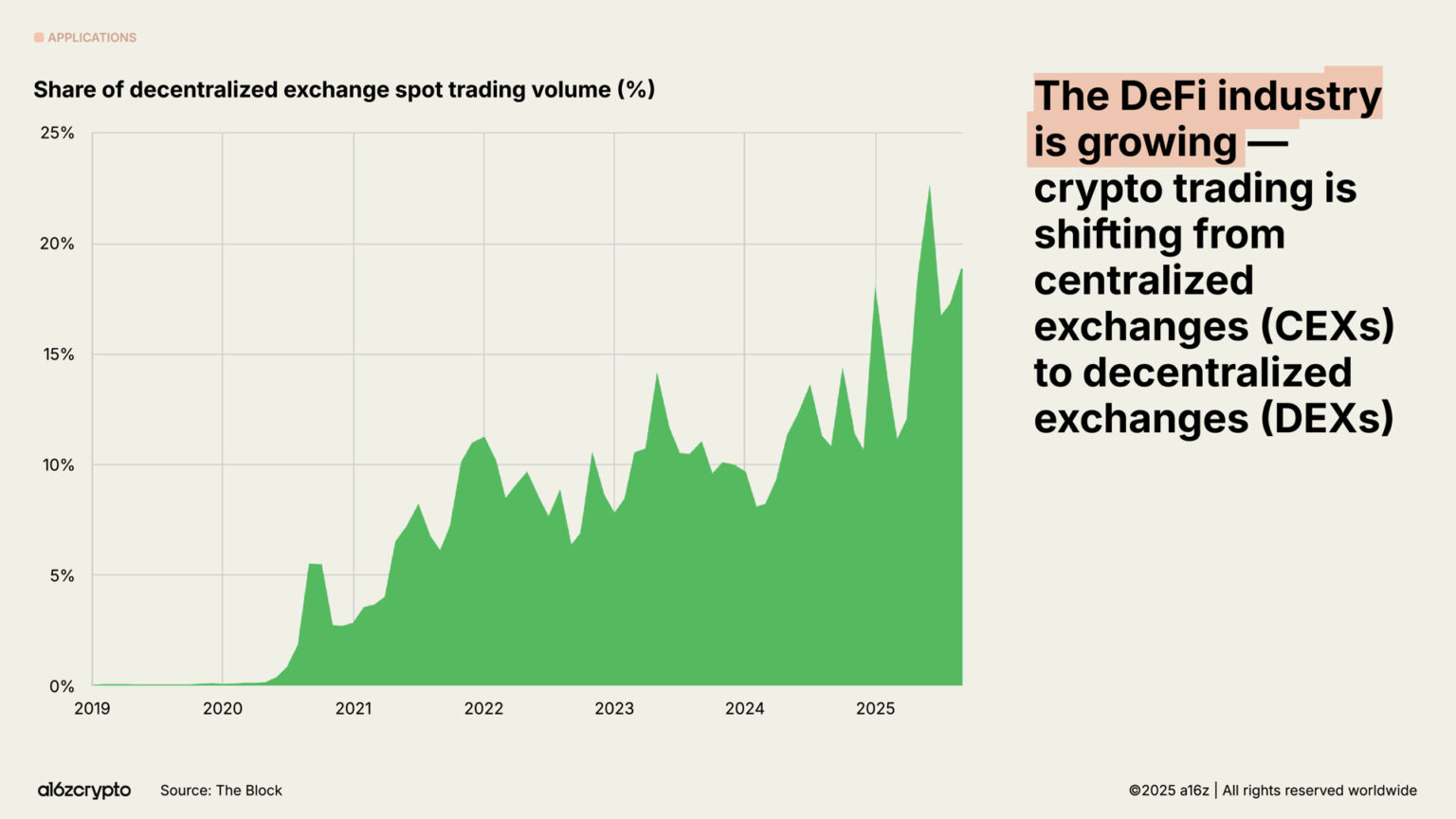
Over the past year, perpetual contract trading volume has increased nearly eightfold, becoming one of the most popular trading categories among cryptocurrency speculators.
Decentralized perpetual contract exchanges like Hyperliquid have processed trillions of dollars in trading volume this year and achieved annualized revenue of over $1 billion - a scale comparable to some centralized exchanges.
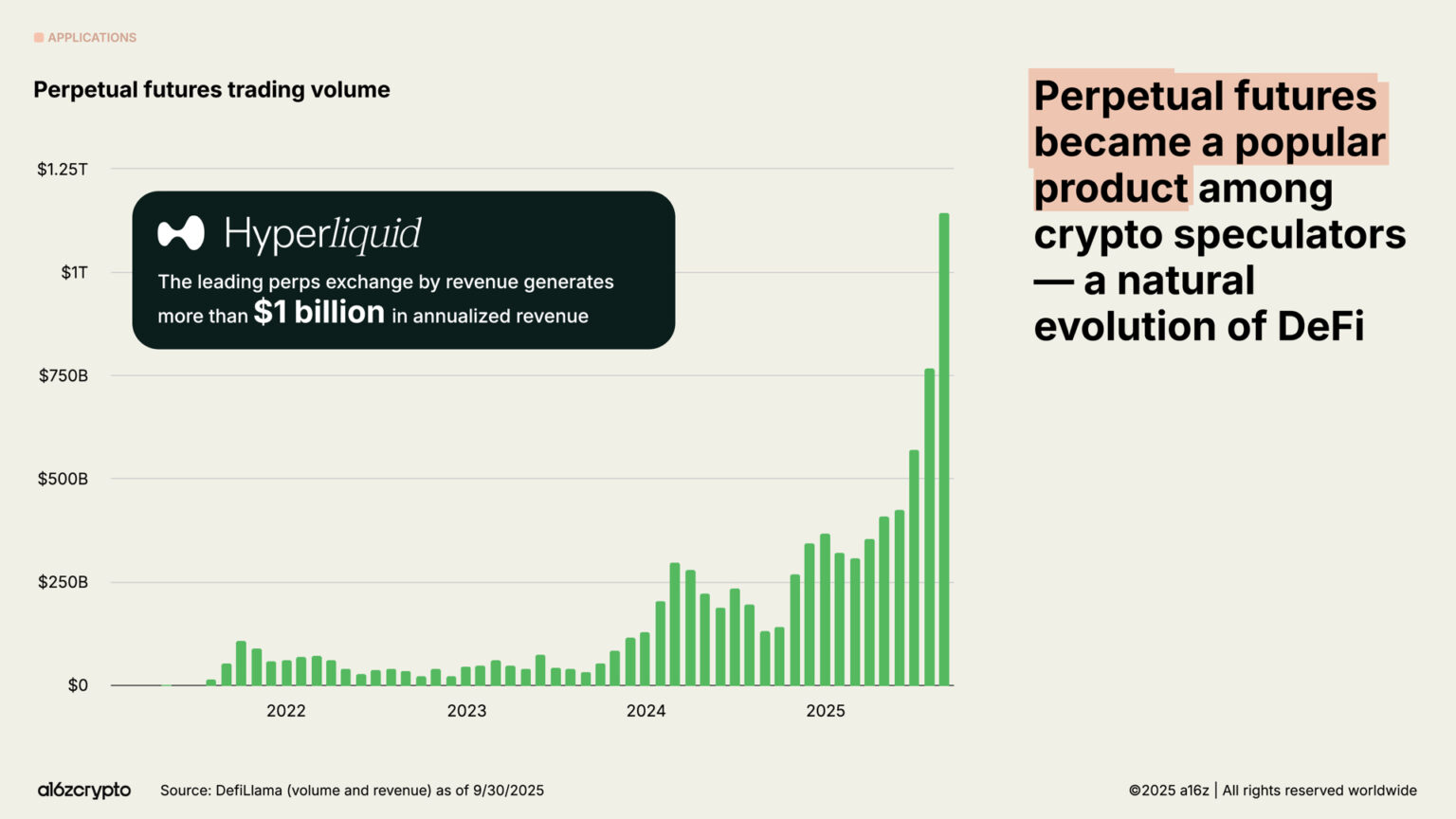
Real-world assets (RWAs)—traditional financial assets like U.S. Treasuries, money market funds, private credit, and real estate that have been on-chain—are bridging the gap between the crypto and traditional financial systems. The tokenized real-world asset market has reached $30 billion, having grown nearly fourfold over the past two years.
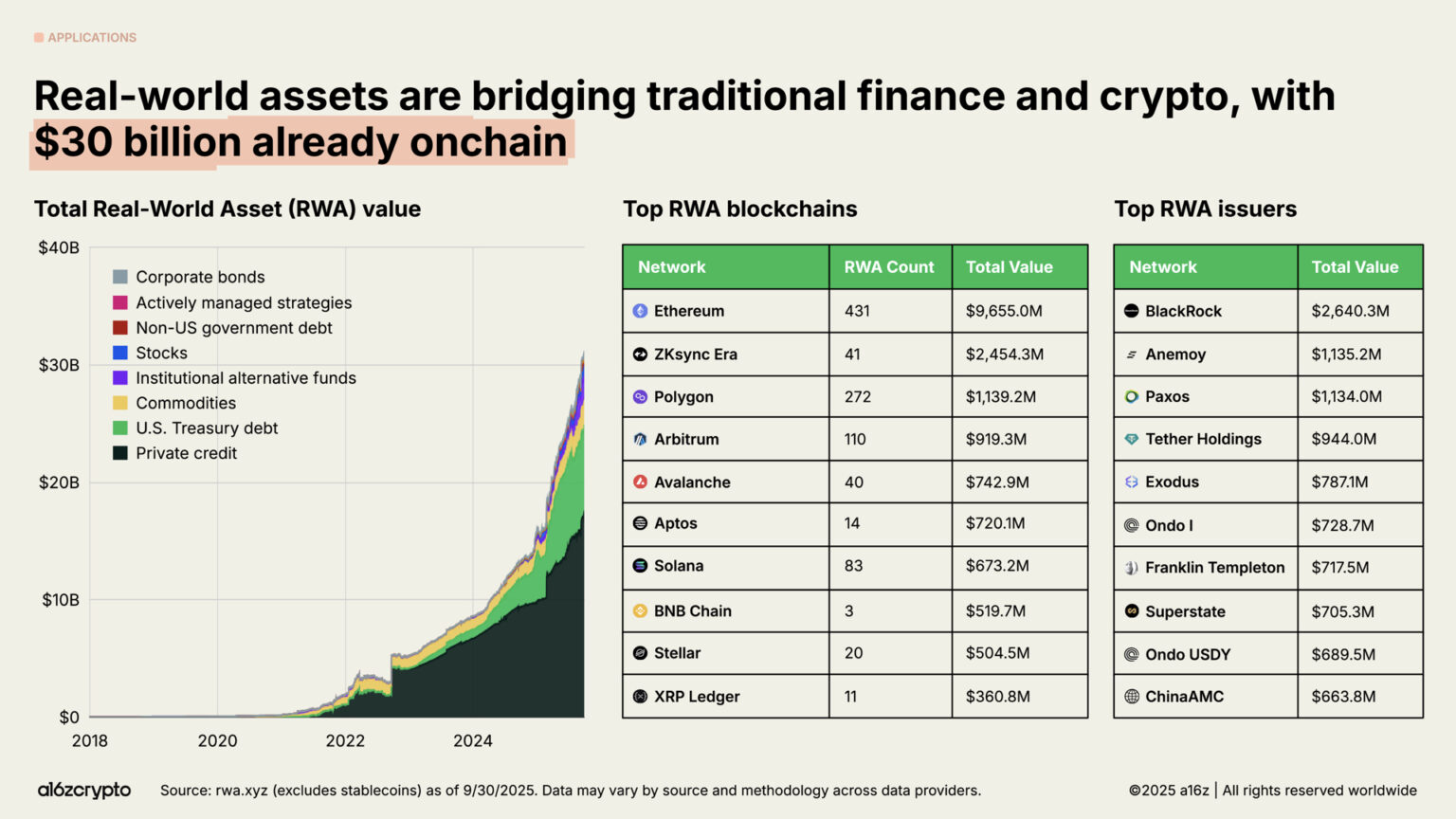
Beyond finance, one of the most ambitious blockchain frontiers in 2025 is Decentralized Physical Infrastructure Networks (DePIN). Just as DeFi has redefined finance, DePIN is reshaping real-world infrastructure—including communications networks, transportation systems, and energy grids. The potential in this area is enormous—the World Economic Forum (WEF) predicts that the DePIN market will reach $3.5 trillion by 2028.
The most well-known example is the Helium Network, a decentralized wireless network operated by users that currently provides 5G cellular coverage to 1.4 million daily active users via over 110,000 user-operated hotspots.
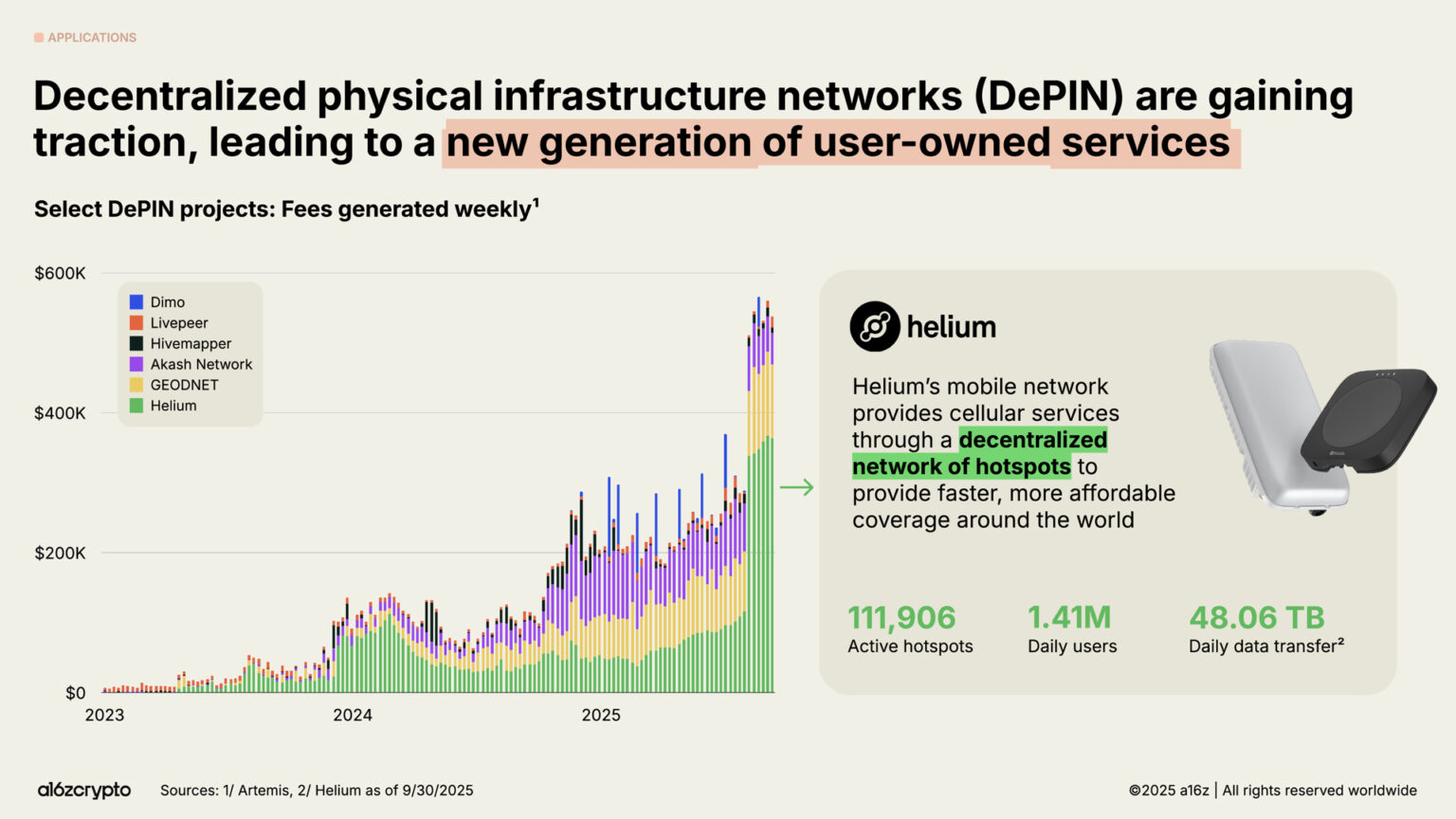
Prediction markets officially entered the mainstream during the 2024 US presidential election cycle. The most popular platforms, Polymarket and Kalshi, saw combined monthly trading volumes reach billions of dollars. Despite skepticism about their ability to maintain their popularity in non-election years, their trading volumes have increased nearly fivefold since the beginning of 2025, approaching all-time highs.
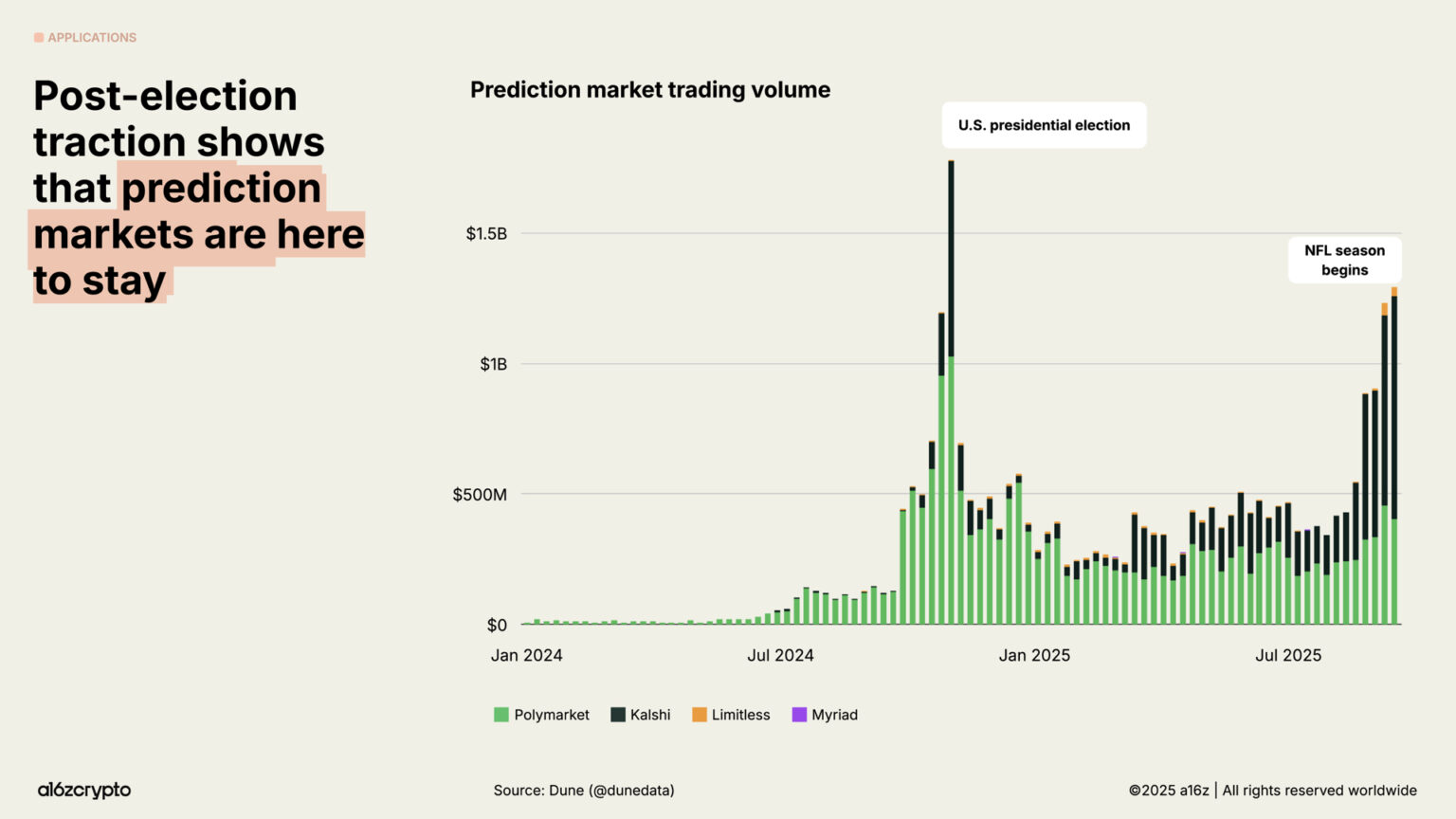
During a period of regulatory uncertainty, meme coins experienced explosive growth. Over 13 million new meme coins were launched in the past year alone. However, this trend has significantly slowed in recent months, with issuance in September 2025 down 56% from January 2025. With a more robust policy framework and bipartisan legislative consensus emerging, the cryptocurrency industry is making room for more productive blockchain applications.
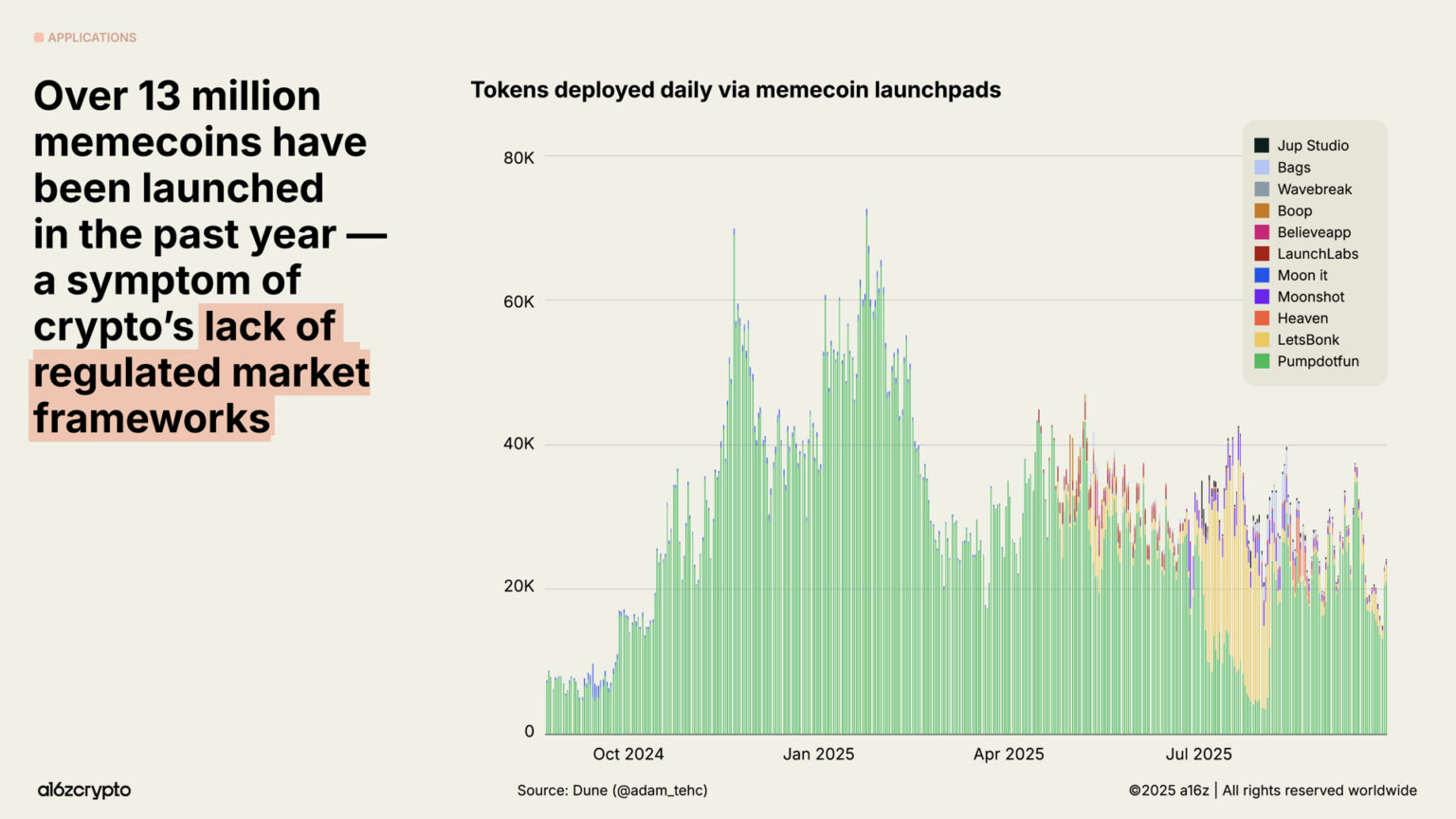
Although the overall transaction volume of the NFT market is far from the peak in 2022, the number of monthly active buyers is steadily increasing. These trends seem to indicate that consumer behavior is shifting from speculation to collection, and the cheaper block space on chains such as Solana and Base provides the conditions for this.
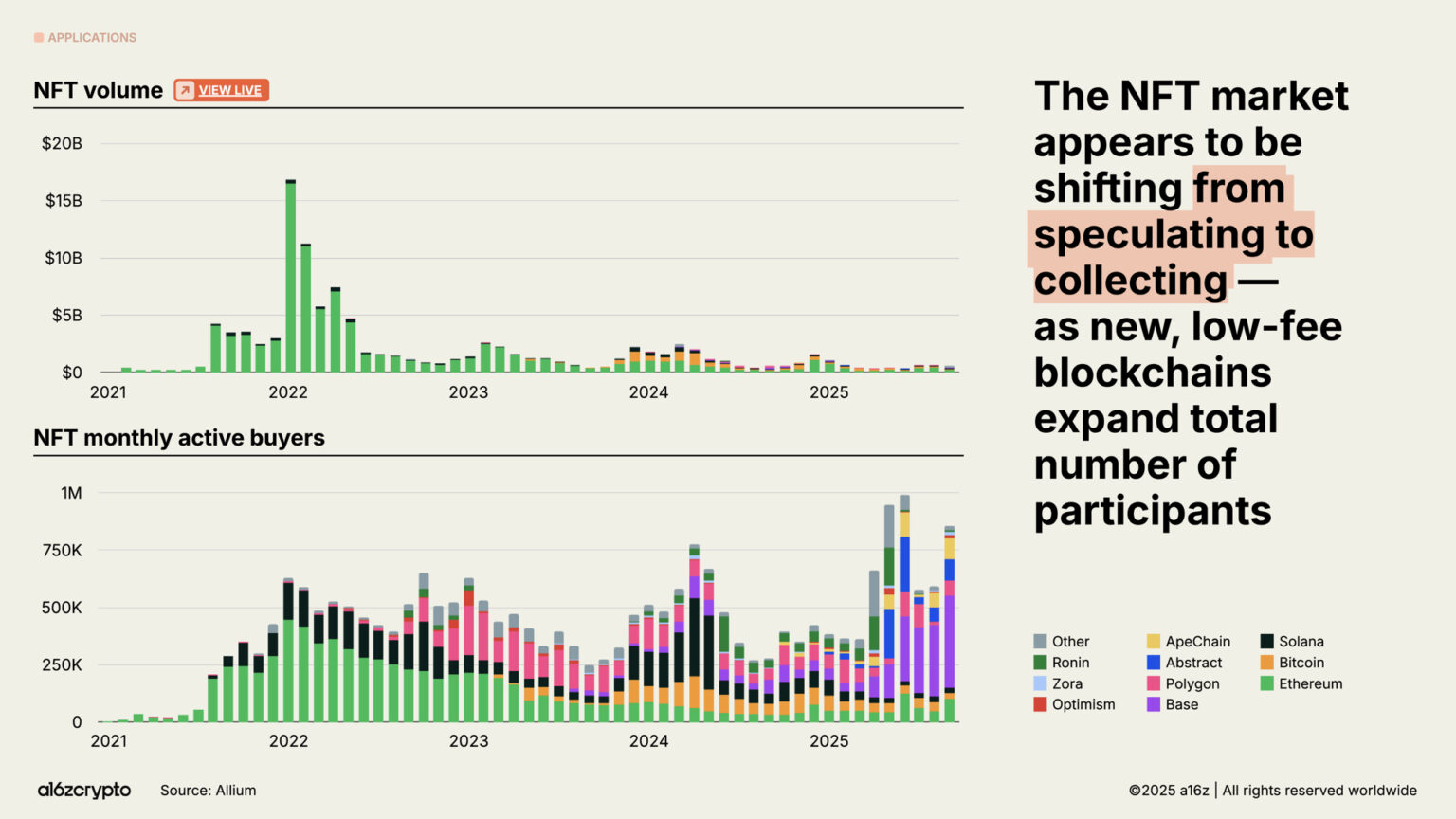
Blockchain infrastructure is ready for prime time
None of the above developments would be possible without significant advances in blockchain infrastructure.
In just five years, the aggregate transaction throughput (TPS) of major blockchain networks has increased over 100-fold. Previously, they could process less than 25 transactions per second; today, blockchains can handle 3,400 transactions per second, a performance comparable to Nasdaq's transaction speeds and even approaching Stripe's global payment throughput during Black Friday—all at a fraction of the cost.
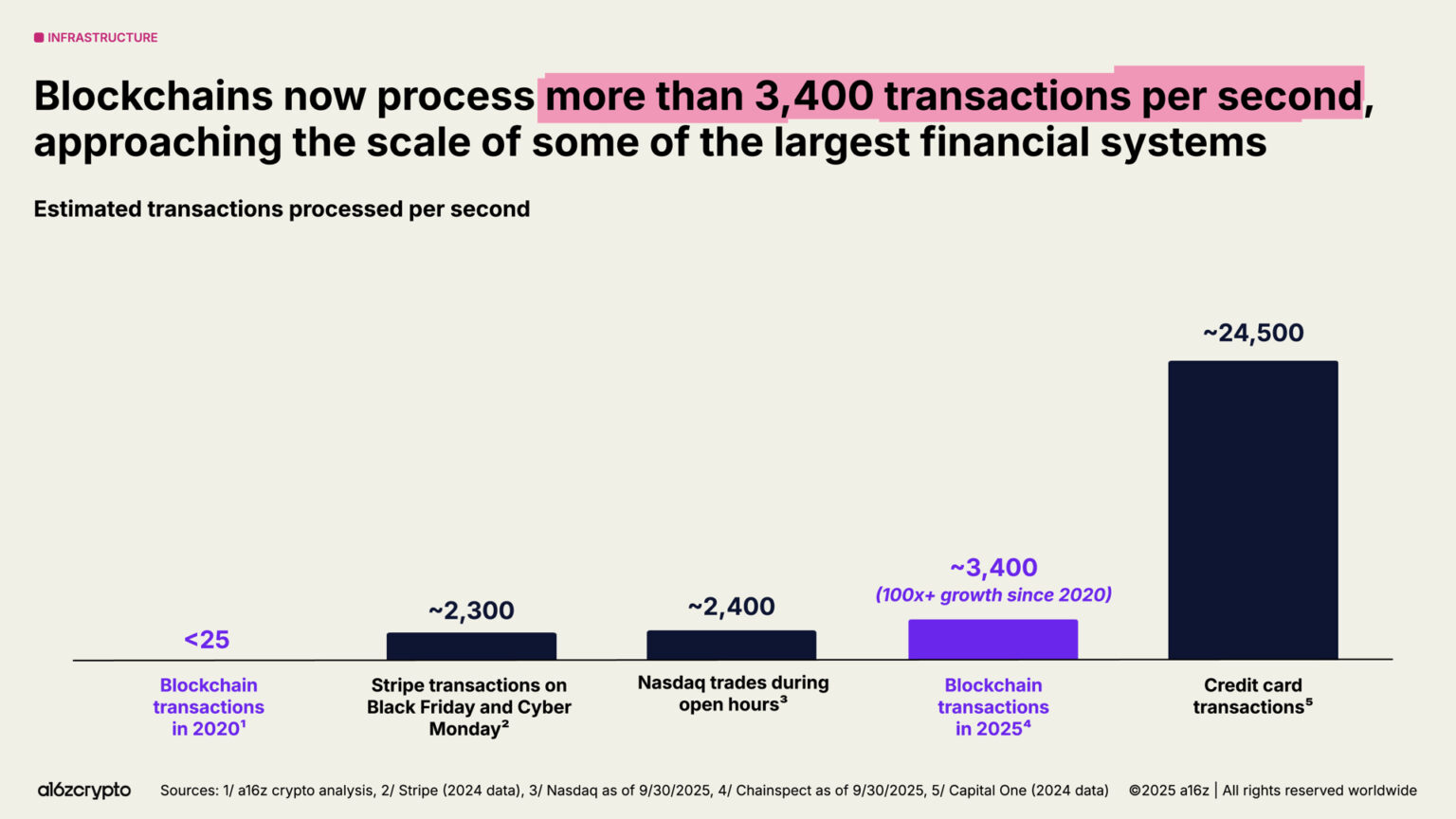
Solana has emerged as one of the most iconic public chains in the blockchain ecosystem. Its high-performance, low-cost architecture now powers a wide range of applications, from DeFi projects to NFT marketplaces. In the past year alone, native applications on Solana have generated over $3 billion in revenue. Solana's upcoming system upgrade is expected to double its network capacity by the end of the year.
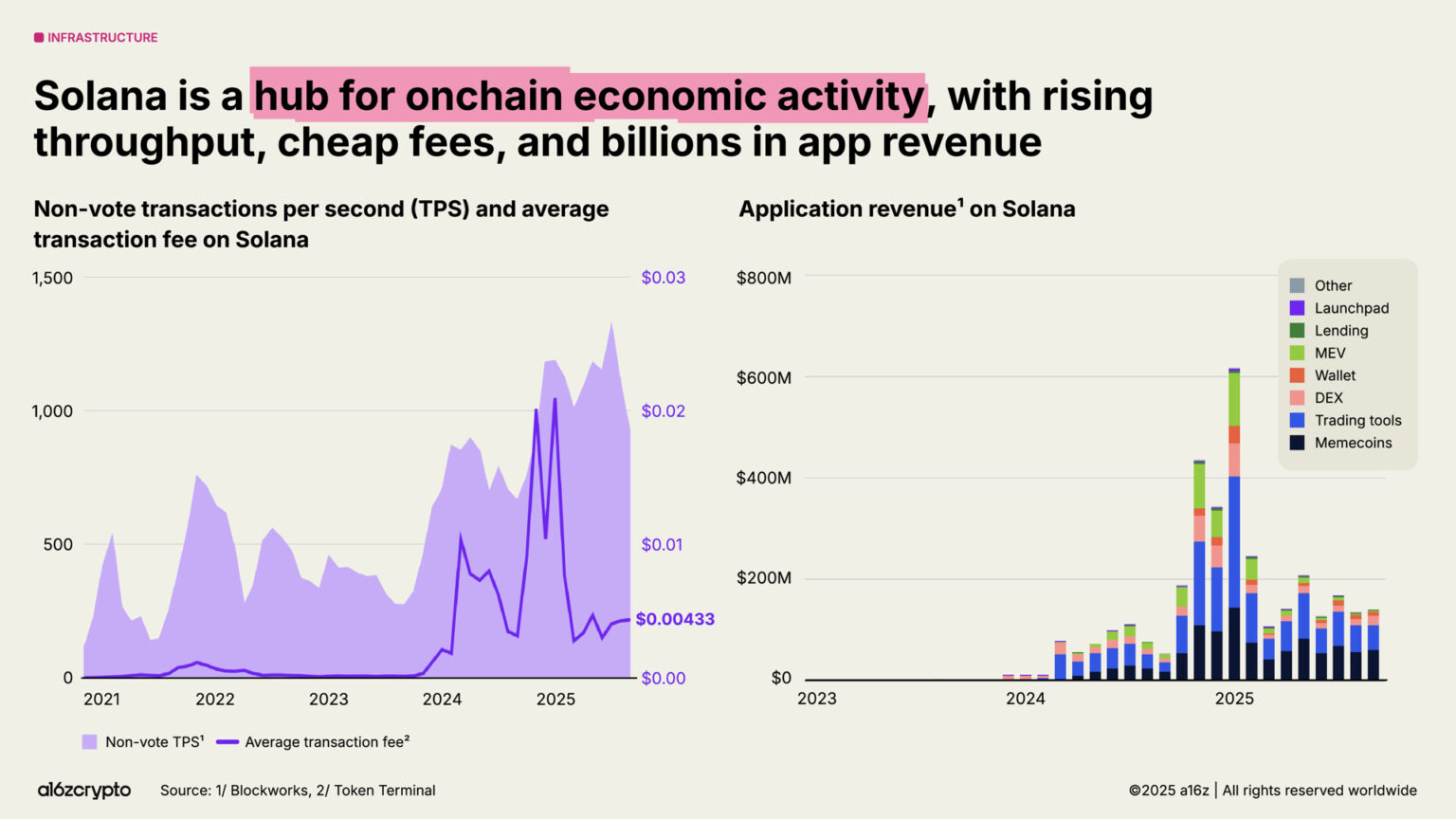
Ethereum continues to advance its scaling roadmap. Currently, the majority of Ethereum's economic activity has migrated to Layer 2 (L2) protocols such as Arbitrum, Base, and Optimism. The average transaction fee on these L2 protocols has dropped from approximately $24 in 2021 to less than 1 cent today, making block space on Ethereum both cheap and plentiful.
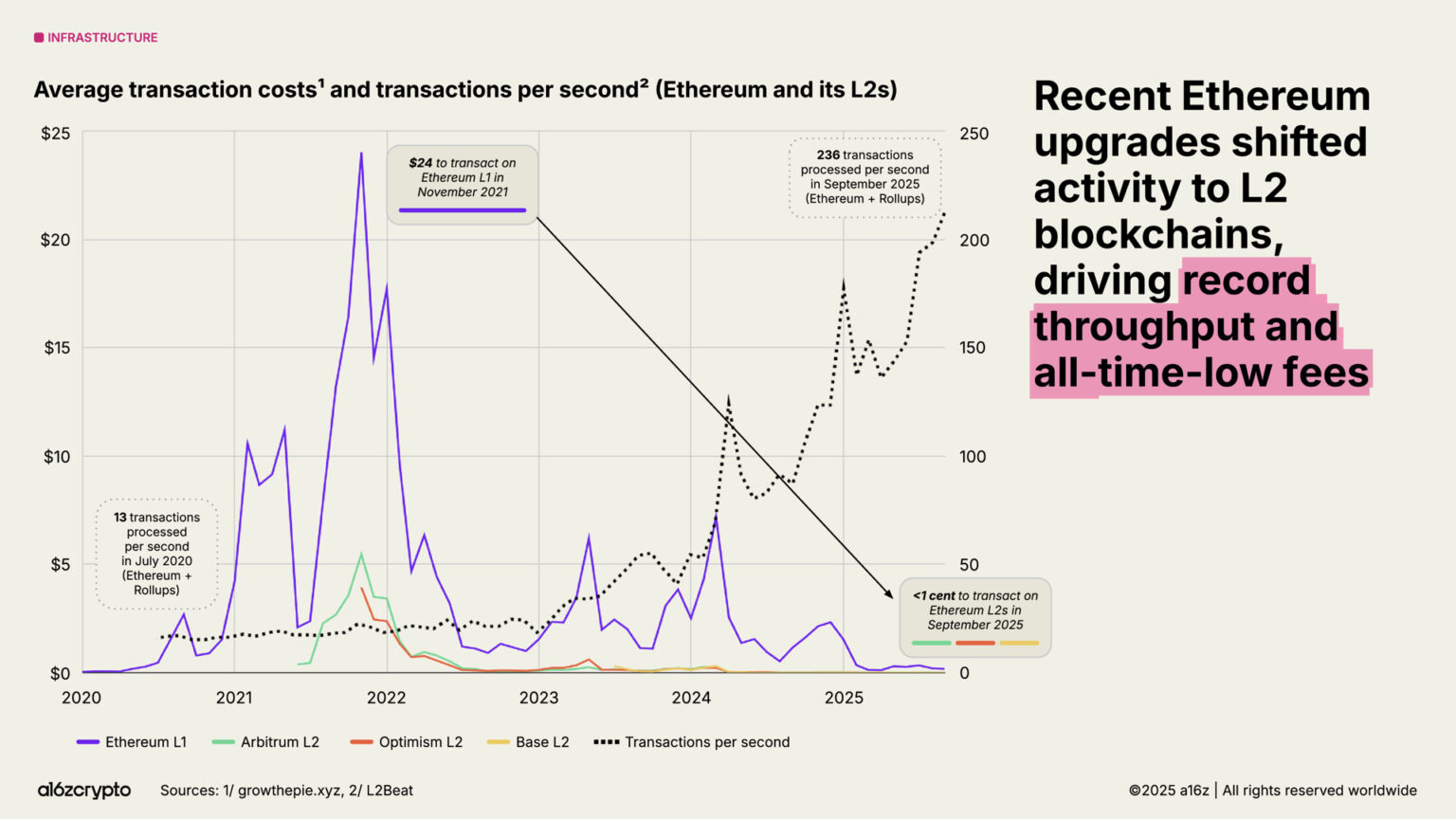
Cross-chain bridges are enabling interoperability between different blockchains. For example, LayerZero and Circle's Cross-Chain Transfer Protocol allow users to freely transfer assets across multiple blockchain systems. Furthermore, Hyperliquid's main bridge has already handled $74 billion in transaction volume this year.
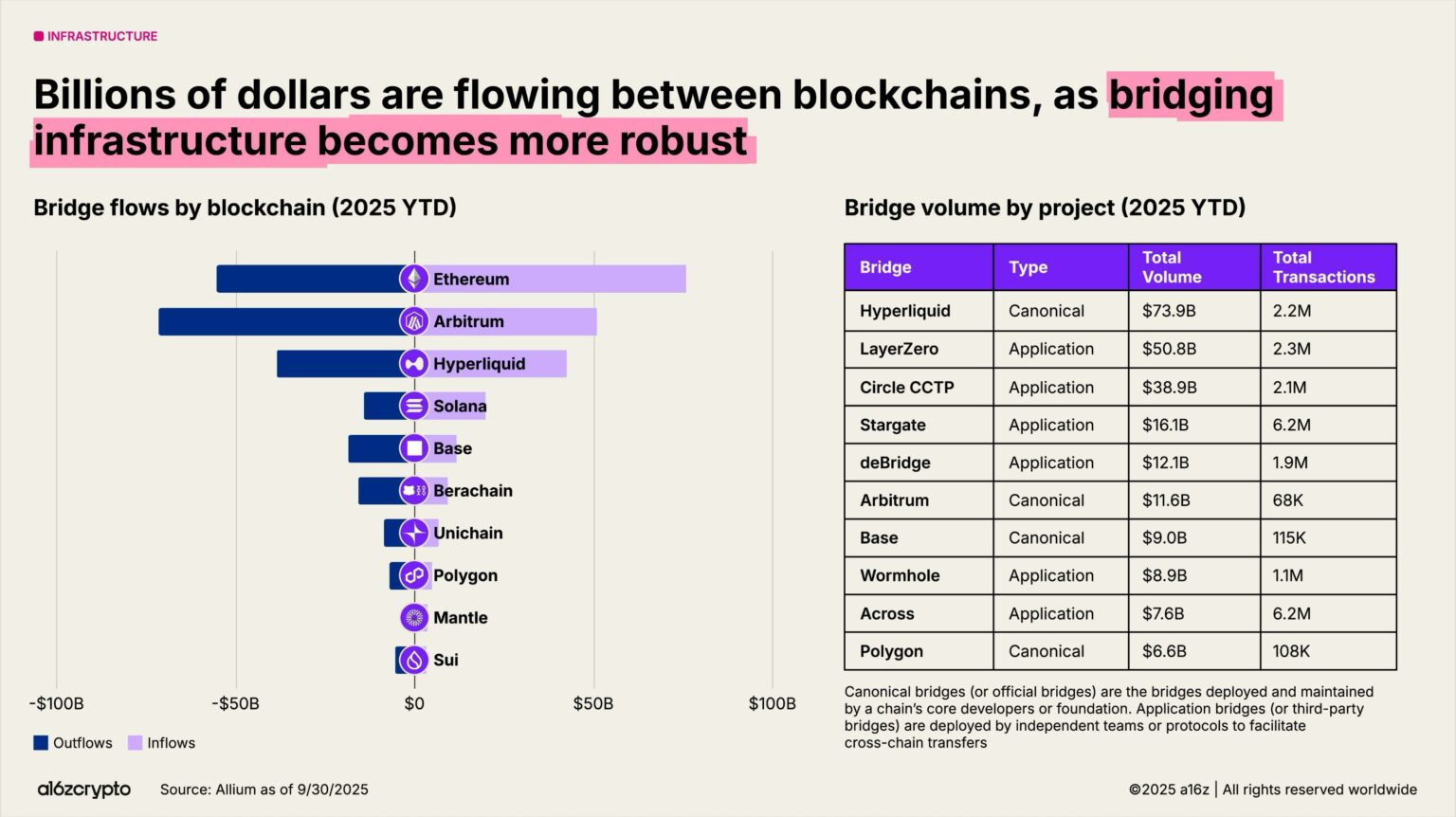
Privacy is returning to the forefront of the cryptocurrency landscape and could become a prerequisite for wider adoption. Several signs indicate growing public interest: Google searches related to "crypto privacy" surged in 2025, Zcash's privacy pool supply grew to nearly 4 million ZEC, and Railgun's monthly transaction volume surpassed $200 million.
More positive signals include the Ethereum Foundation establishing a new privacy team; Paxos partnering with Aleo to launch a compliant privacy stablecoin (USAD); and the U.S. Office of Foreign Assets Control lifting sanctions on the decentralized privacy protocol Tornado Cash... We expect that as cryptocurrency technology continues to move towards the mainstream, this trend will gain greater momentum in the coming years.
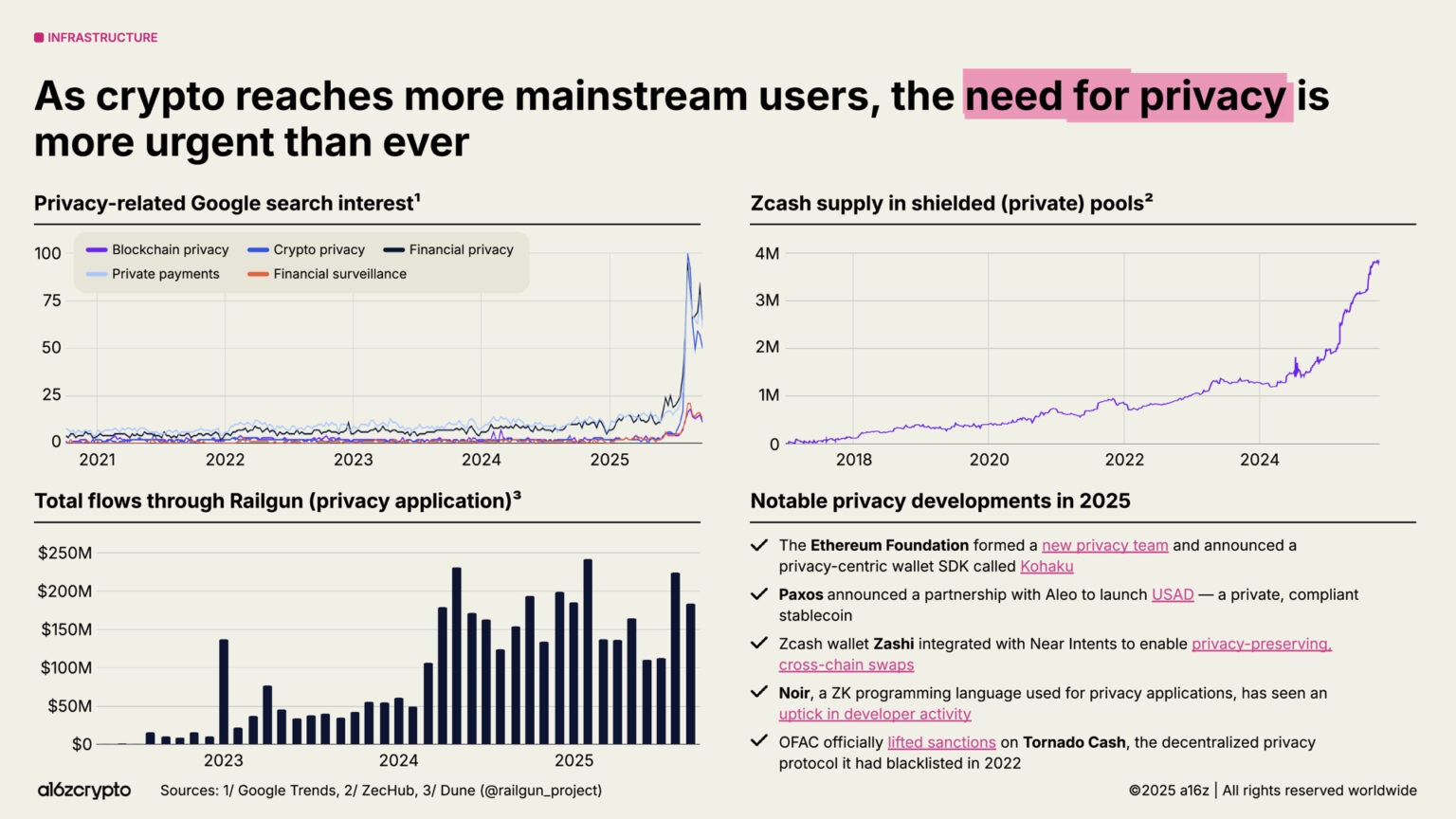
Similarly, zero-knowledge (ZK) proofs and succinct proof systems have rapidly evolved from decades of academic research into critical blockchain infrastructure. ZK technology is now widely integrated into Rollup scaling solutions, compliance tools, and even mainstream internet services—a prime example being Google's ZK identity system.
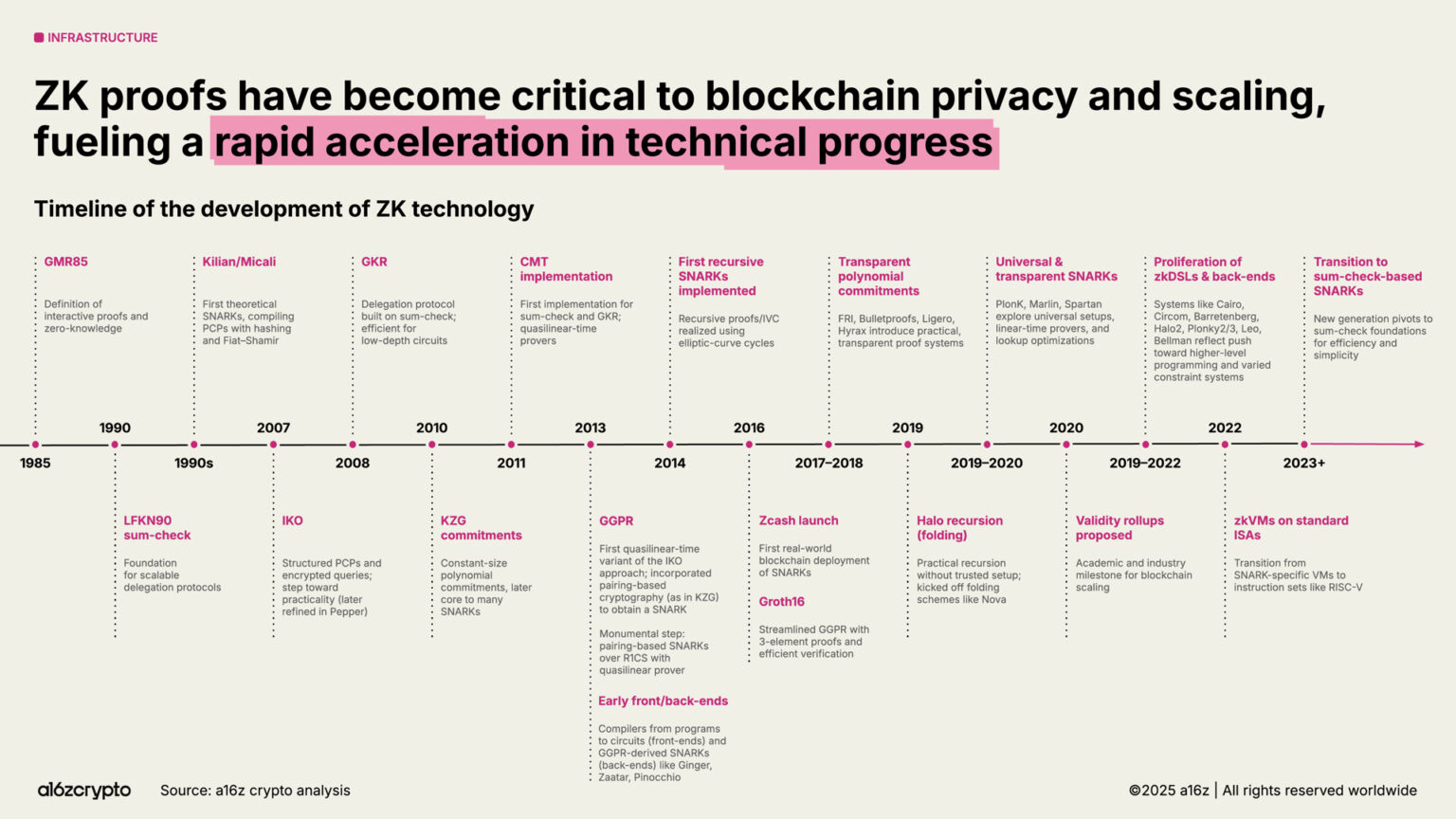
Meanwhile, blockchain is accelerating its quantum-resistance roadmap. Currently, approximately $750 billion in Bitcoin is stored in addresses that could be vulnerable to quantum attacks. The US government plans to fully migrate its federal systems to post-quantum encryption algorithms by 2035.
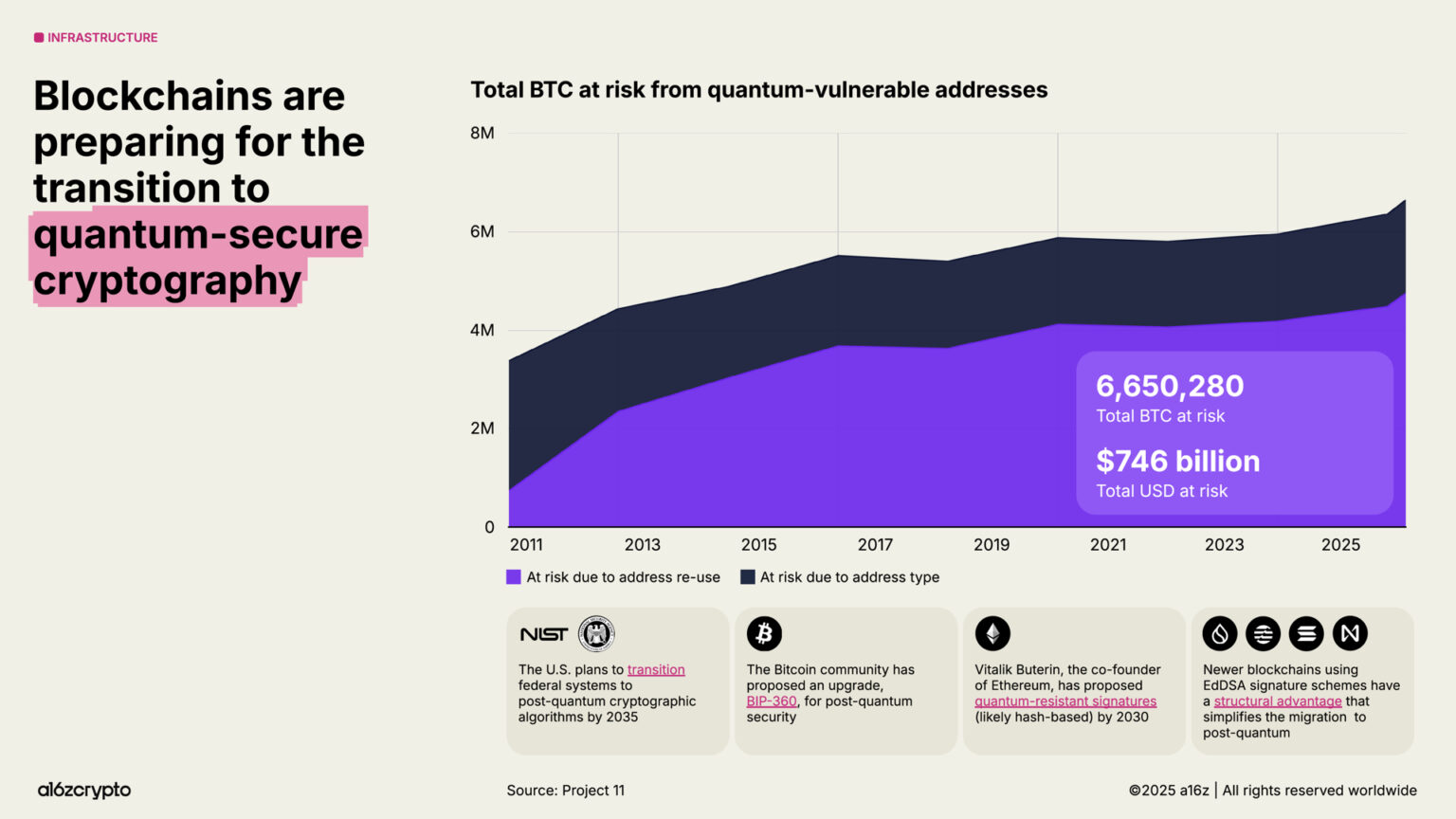
Cryptocurrency and artificial intelligence are merging
Among numerous technological advancements, the release of ChatGPT in 2022 thrust artificial intelligence (AI) into the public spotlight—and this presents significant opportunities for the crypto industry. From tracking data provenance and intellectual property rights to providing payment channels for agents, cryptography may become a key solution to AI's most pressing challenges.
Decentralized identity systems like World, which has verified over 17 million users, can provide “proof of human identity” and help distinguish humans from bots.
Protocol standards such as x402 are emerging as the potential financial infrastructure for autonomous AI agents, enabling them to execute micropayments, access APIs, and complete settlements without intermediaries. Gartner predicts that this AI-driven economy could reach $30 trillion by 2030.
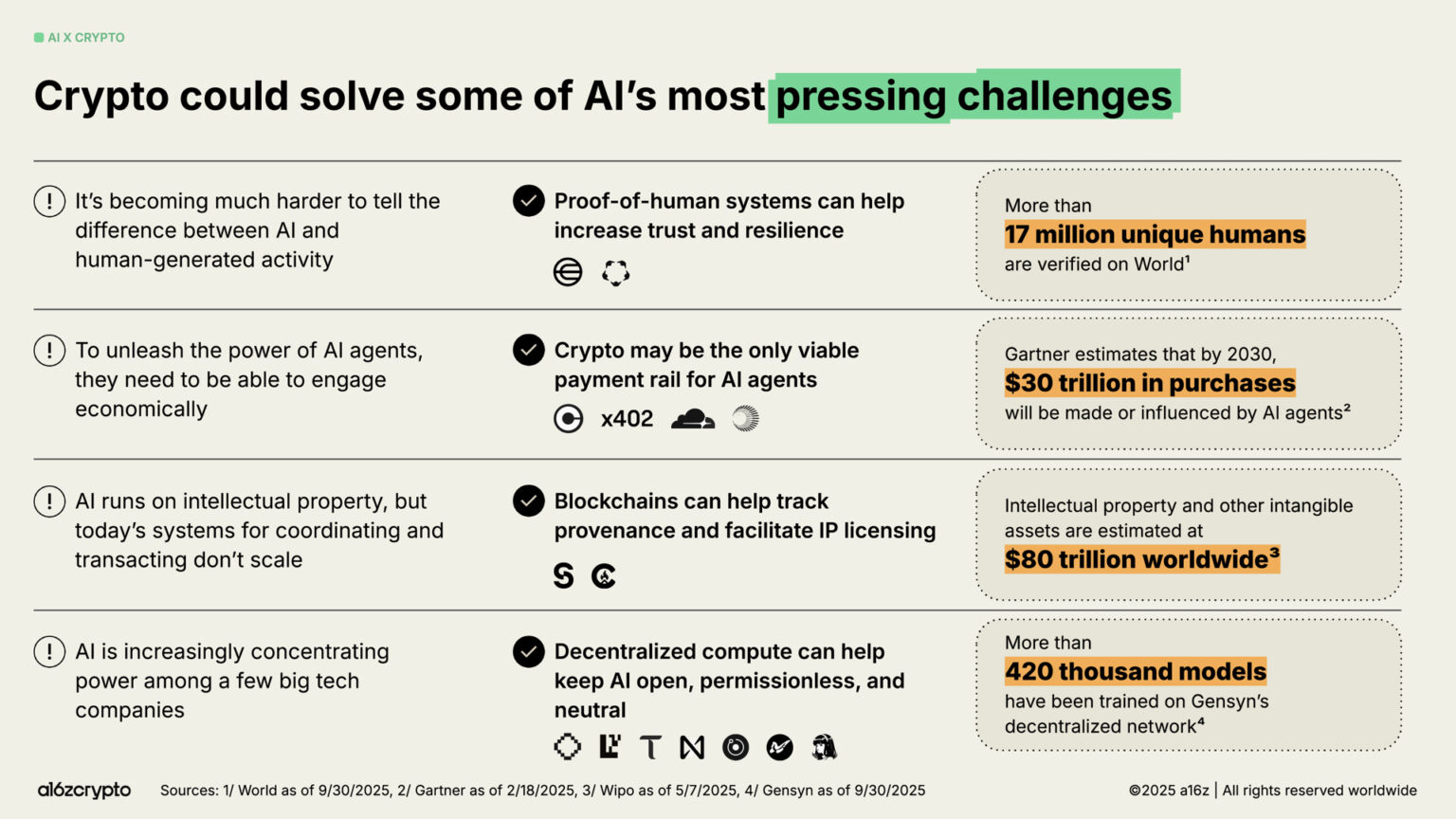
At the same time, the computing layer of AI is increasingly monopolized by a handful of tech giants, raising concerns about centralization and censorship. OpenAI and Anthropic alone control 88% of the revenue of "AI-native" companies; Amazon, Microsoft, and Google control 63% of the cloud infrastructure market; and NVIDIA holds 94% of the data center GPU market. This structural imbalance has contributed to the so-called "Magnificent Seven" achieving double-digit quarterly net profit growth over the past few years, while the remaining 493 companies in the S&P 500 have generally failed to outpace inflation in earnings growth.
Blockchain technology provides a check and balance on the centralization trend of AI systems.
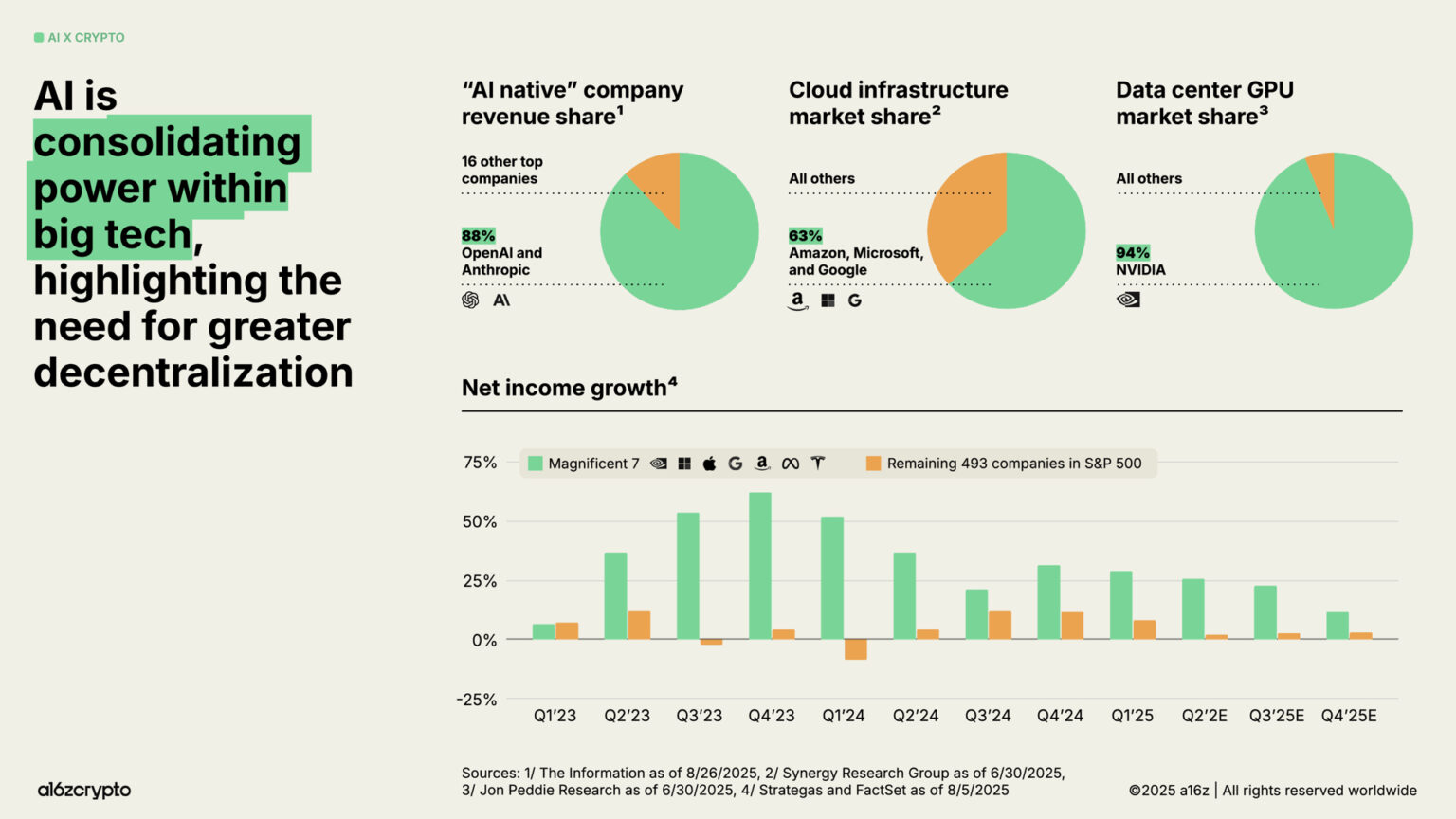
Amid the AI boom, some developers have shifted to the AI field. Our analysis shows that since the release of ChatGPT, approximately 1,000 jobs have shifted from crypto to AI. However, this shift has been almost completely offset by new entrants from traditional finance and technology, with a significant number of developers joining the cryptocurrency industry.
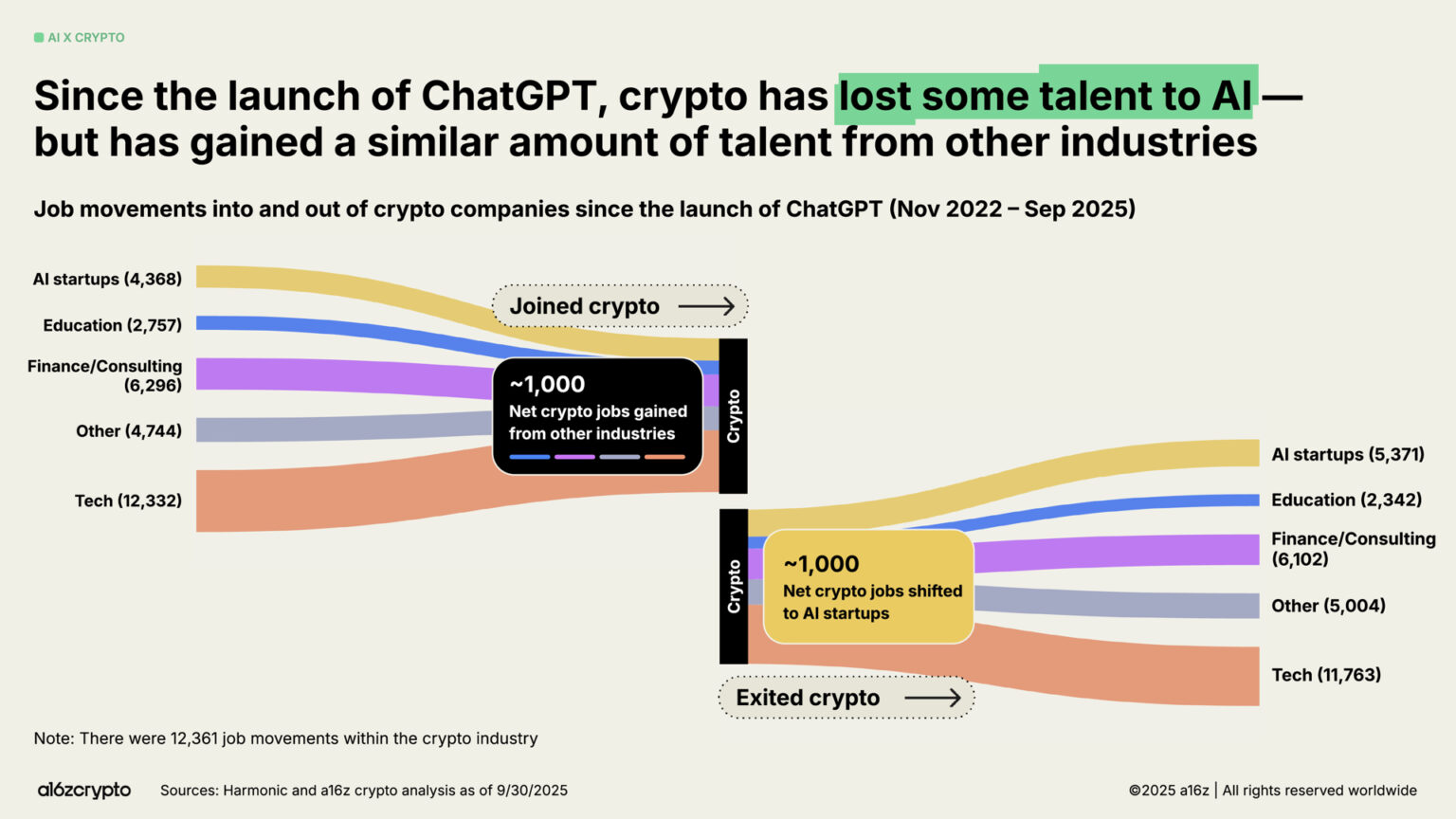
What is the next stage?
So, where are we now?
As the regulatory landscape becomes clearer, tokens are gradually finding a viable path to generating real revenue through transaction fees. Crypto adoption by traditional finance and fintech will continue to accelerate; stablecoins will upgrade the existing financial system and provide financial services globally; and a new generation of consumer products will usher in the next wave of users on-chain.
Now that we have the infrastructure and distribution channels in place, and hopefully a clearer regulatory framework in the near future, to drive this technology into the mainstream, now is the time to upgrade the global financial system, reshape payment networks, and build the internet the world truly deserves.
After seventeen years, the cryptocurrency industry is bidding farewell to its youth and entering a mature development stage.


